STATE OF CALIFORNIA
_____________
RULES FOR CONSTRUCTION OF UNDERGROUND ELECTRIC SUPPLY AND COMMUNICATION SYSTEMS
Prescribed by the
PUBLIC UTILITIES COMMISSION
OF THE
STATE OF CALIFORNIA
GENERAL ORDER No. 128
January 2006
(This Page Intentionally Left Blank)
General Order Number 128
Public Utilities Commission of the State of California
Rules for Construction of Underground Electric Supply and
Communication Systems
![]()
Adopted October 17, 1967 Effective December 12, 1967
Decision No. 73195 and 73462, Case No. 8208
![]()
Change list- The following is a list of Decisions and Resolutions which authorized statewide general changes to this Order, applicable to all operators of underground systems.
Decision or Resolution No. |
Date Effective |
Rules Herein Revised, Deleted or Added |
Decision No. 76970 |
April 13, 1970 |
12.3, 12.3-A, 12.3-B, 12.3-C, 17.2, 17.8, 23.2.1 31.5-D, 31.6,32, 41.5-C, 41.6, 42.3, 42.4, 42.8, Figures 17 and 18 |
Resolution No. E-1401 |
July 16, 1974 |
36.5-A |
Resolution No. E-3076 |
March 9, 1988 |
Revise 41.4-C2, Add 43.3-C, D |
Resolution No. SU-6 |
November 21, 1990 |
Add Rules 12.2-A, 22.4 |
Resolution No. SU-15 |
November 6, 1992 |
Revise Rules 20.2, 20.4. |
Resolution No. SU-25 |
January 19, 1993 |
Revise Rules 36.3, 36.4. |
Resolution No. SU-40 |
October 9, 1996 |
12.1, 12.3, 20.1, 20.2, 20.5, 20.6, 20.7, 20.8, 20.9, 21.0, 21.2, 21.4, 21.5, 21.6, 21.8, 21.9, 22.1, 22.2, 22.5, 22.7, 23.6, 23.7, 32.9, 34.2, 44.1, 46.1 |
Decision No. 0501030 |
January 13, 2005 |
12.4, 17.1, 17.8, 18, 20.2, 22.10, 31.6, 34.3-B, 35.2, 41.6, 44.1 |
Decision No. 73195
Before the Public Utilities Commission of the
State of California
![]()
Investigation into the Requirements for a General Order Providing Rules Governing Construction of Underground Electric and Communication Lines in the State of California.
Case No. 8208
Decided October 17, 1967
![]()
Earl W. Cooper, Richard G. Campbell, for Sierra Pacific Power Company; Chickering & Gregory, by Sherman Chickering, G. Hayden Ames and Donald J. Richardson, Jr. also J. A. George and Stanley Jewell, for San Diego Gas and Electric Company; Orrick, Dahlquist, Herrington & Sutcliffe, by James F. Craft, Jr., also N. B. Gilbertson, for California-Pacific Utilities Company; William W. Eyers, for Southern California Water Company; A. E. Engel, for Plumas-Sierra Rural Electric Cooperative; A. M. Hart and H. Ralph Snyder, Jr., by H. Ralph Snyder, Jr., for General Telephone Company of California; Pillsbury, Madison & Sutro; John A. Sutro, George A. Sears, John A. Sutro, Jr., Arthur T. George, by George A. Sears and John A. Sutro, Jr., for The Pacific Telephone and Telegraph Company; F. T. Searls, John C. Morrissey, Malcolm A. MacKillop and Ross Workman, for the Pacific Gas and Electric Company; Rollin E. Woodbury, Harry W. Sturges, Jr., and John R. Bury, for Southern California Edison Company; Jack T. Stiles, for Pacific Power and Light Company; George W. Allen, for California Interstate Telephone Co.; respondents.
William J. Adams, for the City of Novato; Robert S. Binsacca, for the City of El Cerrito and for Contra Costa County Mayors' Conference; John Bonadelle, for Home Builders, Fresno; Russell E. Bush, for the City of Vallejo; William C. Sharp, H. W. Carmack, for the City of Oakland; James S. Milch, Hubert C. Cavanagh, for the City of San Diego; K. R. Edsall, Eric W. Martins, H. L. Goth, for Southern California Gas Company and Southern Counties Gas Company of California; Harvey W. Edmund, Henry J. Fritz, for County of Santa Cruz; C. G. Ferguson, J. A. Wade, Jr., P. M. Robinson, for California Water Service Company; Wayne N. Frederickson, for Alameda County; Warren Earl Standeven, George Harris, for State of California, Division of Industrial Safety; Harold H. Heidrick, for Wilsey, Ham & Blair; Marino L. Iacopi, for California Community Television Association; Stanley S. Johnson and Joe Pecharich, for San Mateo County Engineers Office and Building Construction Office; Henry E. Jordan, Roy A. Wehe, Phil J. Shafer, for City of Long Beach; Thomas P. Kelly, Jr. Harold S. Lentz, Gary S. Anderson, John Gordon for Southern Pacific Company, Northwestern Pacific Railroad Company, San Diego-Arizona Eastern Railway; N. J. Kendall, for San Jose Water Works; Mark L. Kermit, for Contra Costa County; Bruce V. Kunde, for Line Material Industries; Gayle T. Martin, for City of Manhattan Beach; Robert E. Michalski, J. S. Taylor, for City of Palo Alto; Ralph E. Mohagen, for City of Richmond; Morgan, Beauzay & Holmes, by David W. Leahy, for San Francisco Bay Area Labor Management Committee for the Bay Area; Thomas M. O'Connor, McMorris Dow, Robert R. Laughead, for City and County of San Francisco; Paul E. Pugh for City of Healdsburg; Arthur W. Reschke, Henry Weisner, for City of Daly City; Maurice K. Roper, for Ukiah Municipal Electric System; Norman J. Stiene, for Town of Hillsborough, Ernest L. Nelson, Stanley Strizver, for City of San Leandro; M. A. Walters, for Local Unions 18, 47, 465, and 1245 International Brotherhood of Electrical Workers; H. L. Woodbury, for City of Glendale Public Service Department; Fred F. Cooper, for Home Builders Council of California; Sidney Long, for Division of Building and Housing Standards, Department of Housing and Community Development; Ernest E. Lockwood, for Central Solano County Planning Commission, City of Fairfield and City of Suisun; George H. Harter, for Electrical Contractors Association; Arne E. Westerback, for East Bay Municipal Utility District; J. D. Newton, Alameda
County Water District; David W. Baker, for Alameda-Contra Costa Counties Mayor Conferences; Norman Ingraham, for City of Santa Clara and NCMEA; George D. Moe, for State of California, Department of Public Works; John W. Gancy, Walter G. Treanor, for the Western Pacific Railroad; Ralph E. Anderson, Daniel J. Curtin, Jr. for League of California Cities; H. Stuart Goehler, for California-Nevada Line Constructors Chapter, National Electrical Contractors Association; J. L. Mulloy, for Department of Water and Power, City of Los Angeles; Stanley Hiller, in propria persona; C. G. Ferguson, for California Section of American Water Works Association; Jan Staklis, for William E. Warne, Department of Water Resources; Lynden E. Merritt, for Allen System; Herbert H. Hunt, Donald M. Haight, for Sacramento Municipal Utility District; Herbert B. Fuster, Jr., for Department of Public Health, State of California; Roger Arnebergh, by Charles E. Mattson, C. E. Robinson, for City of Los Angeles; interested parties.
Timothy E. Treacy, Robert C. Marks, Melvin E. Mezek, for the Commission staff.
(This Page Intentionally Left Blank)
Opinion
![]()
Nature of Proceeding
The Commission, on June 22, 1965, noting that the increasing demand for underground electric and communication facilities in California has brought about substantial increases in the construction of such facilities, and that it appeared it may be desirable, pursuant to Sections 761, 768 and 8056 of the Public Utilities Code, to establish by general order rules governing the construction of underground electric and communication lines to promote and safeguard public health and safety, instituted this investigation.
Public Hearings and Proceedings Prior to Submission
Public hearings were held, after due notice, at San Francisco and Los Angeles, before Commissioner Gatov and/or Examiner Gillanders on 20 days during the period beginning October 20, 1965 and ending May 2, 1966. During this period prehearing conferences were held. (Rules of Procedure, Rule 41.) Opening briefs were filed on June 10, 1966, reply briefs on June 20, 1966, and the matter then taken under submission.
General Remarks
During the course of the proceeding, evidence was adduced from 30 witnesses, 43 exhibits were received and 2,733 pages of transcript were recorded.
The record shows that, as between the parties, there are two issues. These issues are:
1. Is there a need for a general order?
2. Can the State preempt the field in the regulation of safety relative to underground electrical and communications facilities?
Is There a Need for a General Order?
The record shows that California electric and communications utilities began installing their facilities underground during the latter part of the 19th century.
Undergrounding proceeded at a leisurely pace until about five years ago. Since then, due to a combination of accelerated public interest and technical developments which substantially reduced the cost of undergrounding, a large percentage of new residential developments have been supplied from underground distribution systems.
The record indicates that respondent utilities have followed acceptable standards of care based upon past experience and are continuing to improve methods of construction, including joint construction with other utilities, to better serve the public and reduce costs.
The evidence further discloses that the present underground electrical and communications systems cannot be considered hazardous and the safety record is good.
It is recognized, however, that not only has undergrounding been growing rapidly using new equipment, techniques and material, but in keeping with the Commission's policy of encouraging, and when necessary ordering, more and more utilities' distribution systems to be buried, this pace will be greatly accelerated. This is not to say, therefore, that because of a good past record we should not do what we can now to avoid serious accidents or fatalities in the future.
Can the Commission Preempt the Field of Safety Regarding Underground Electrical and Communications Facilities?
Pursuant to Article XII, Sections 22 and 23 of the California Constitution, the Legislature enacted Sections 701, 761 et seq., and 8037 of the Public Utilities Code. Under this authority the Commission has undertaken to exercise its jurisdiction by the enactment of several general orders, such as General Order No. 95 governing the construction of overhead electric lines, General Order No. 103 governing the construction of water service facilities, and General Order No. 112-A governing the construction of gas transmission lines. These general orders promote safety, not only to the public utility involved and its employees, but also to the public in general. There can be little doubt that a uniform statewide policy of safety regulation is in the general public interest. Such matters are not solely matters of local interest and concern. The Commission, being a constitutional body exercising statewide jurisdiction, is the logical agency of the State to exercise authority of this nature.
It is this Commission which regulates the operations of public utilities to the end that their services to the general public are adequate and safe. Regulation of safety is cognate and germane to the regulation of public utilities.
Changing times and changing conditions require the Commission to exercise its right and duty to establish rules governing the construction, maintenance and operation of underground electric and communication facilities.
We come now to the consideration of the proposed general order itself (Exhibit No. 11). The precision and detail which marks our safety regulations in older or better-established engineering and operational techniques is, it is true, evident here only in part. We are aware that a considerable part of this proposed general order is, as our staff itself pointed out, only a foundation of broad principles on which details can be built. This does not in our view constitute a deficiency or flaw. To the contrary, we deem it prudent to have in being a vehicle, however embryonic, for immediately capitalizing experiences as they occur.
Findings
The Commission finds that it has the right, pursuant to Article XII, Section 23, of the California Constitution and Sections 701, 761, et seq., and 8056 of the Public Utilities Code, to establish the rules contained in Exhibit No. 11 governing the construction, maintenance and operation of underground electric and communication facilities.
The Commission further finds that the rules contained in the attached General Order No. 128 are reasonable, meet the aforesaid requirements and should be adopted.
All motions not consistent with the findings herein are denied.
Order
![]()
It Is Ordered that General Order No. 128 attached hereto be and it hereby is adopted. Said General Order No. 128 shall apply to all underground electric supply and communication systems coming within the jurisdiction of this Commission, and shall be effective on December 1, 1967. 1
It Is Further Ordered that the electric and communication utilities subject to these rules, either individually or collectively, shall file annually on or before June 30 a report setting forth such recommended changes in rules as they deem necessary to keep this general order up to date in keeping with the purpose and scope thereof, or stating that no changes are deemed to be necessary. Utilities recommending changes shall, either collectively or otherwise, file appropriate formal applications seeking Commission approval for such changes. However, nothing herein shall preclude other interested parties from initiating appropriate formal proceedings to have the Commission consider any changes they deem appropriate, or the Commission from acting upon its own motion.
The effective date of this order shall be twenty-five days after the date hereof.
Dated at San Francisco, California, this 17th day of October, 1967.
Peter E. Mitchell
President
William M. Bennett
A. W. Gatov
William Symons, Jr.
Fred P. Morrissey
Commissioners
___________________
1 Petition for rehearing filed by the State of California, Department of Public Works, Division of Highways, stayed Decision No. 73915 until December 12, 1967, when the petition was denied by Decision No. 73462.
Table of Contents
![]()
Rule Page
![]()
Section I General Provisions
11. Purpose of Rules I-1
12. Applicability of Rules I-1
12.1 Construction and Reconstruction of Lines I-1
A. Services I-1
12.2 Maintenance I-2
A. Electric Supply System I-2
12.3 Systems Constructed Prior to These Rules I-2
A. Rule Applicable December 12, 1967 I-2
B. Rules Applicable April 13, 1970 I-3
C. Rules Applicable April 13, 1971 I-3
12.4 Reconstruction or Alteration I-3
12.5 Third Party Nonconformance I-4
13. Scope of Rules I-4
14. Limiting Conditions Specified I-4
15. Exemptions or Modifications I-4
15.1 Changes and Special Installations I-5
15.2 Experimental Installations I-5
15.3 Notification I-5
16. Saving Clause I-6
17. Requirements for All Supply and Communication Systems I-6
17.1 Design, Construction and Maintenance I-6
17.2 Inspection I-6
17.3 Location I-7
17.4 Joint Use of Excavations and Facilities I-7
17.5 Two or More Systems I-7
17.6 Encroachments I-7
17.7 Location Information I-7
A. Records I-8
Rule Page
![]()
17.8 Identification of Manholes, Handholes and Subsurface
Equipment Enclosures I-8
17.9 Measurements I-8
17.10 Backfill of Excavations I-8
18 Investigation of Accidents I-9
Section II Definitions of Terms as Used in These Rules
20.1 Bond II-1
20.2 Cable II-1
A. Buried Cable II-1
B. Fiber Optic Cable II-1
C. Dielectric Fiber Optical Cable Facility II-1
20.3 Commission II-1
20.4 Communication System II-1
A. Public Communication System II-1
B. Private Communication Circuit II-2
C. Railway Signal Circuit II-2
20.5 Concurrently Installed II-2
20.6 Conductor II-2
20.7 Conduit II-2
20.8 Conduit System II-2
20.9 Cover II-2
20.10 Duct II-2
21.1 Element II-3
21.2 Enclosed II-3
21.3 Exposed II-3
21.4 Grade II-3
21.5 Grounded II-3
A. Effectively Grounded (Effective Ground) II-3
21.6 Guarded II-3
21.7 Handhole II-3
Rule Page
![]()
21.8 Independently Installed II-4
21.9 Interconnection II-4
22.0 Isolated II-4
22.1 Joint Trench Operation II-4
22.2 Live (Energized) Parts II-4
22.3 Maintenance II-4
22.4 Maintenance Program II-4
22.5 Manhole II-4
22.6 Parkway II-4
22.7 Permanent Cable Trench II-5
22.8 Practicable II-5
A. Clearances and Depths II-5
22.9 Protection (Mechanical) II-5
22.10 Qualified II-5
23.0 Random Separation II-5
23.1 Service(s) II-5
23.2 Shielding (Cable) II-5
23.3 Sidewalk II-5
23.4 Subsurface Equipment Enclosure II-5
23.5 Supply System II-6
23.6 Thoroughfare II-6
23.7 Vault II-6
23.8 Voltage (or Volts) II-6
24.0 Wire Gage II-6
A. American Wire Gage (AWG) II-6
B. Birmingham Wire Gage (BWG) II-6
24.1 Working Space II-6
Section III Requirements for Supply Systems
30. General III-1
31. Duct System III-1
31.1 Definition III-1
Rule Page
![]()
31.2 Maintenance and Inspection III-1
31.3 Construction III-1
31.4 Clearance and Depths III-1
A. From Foreign Substructures III-1
(1) Independently Installed III-2
(2) Concurrently Installed III-2
B. From Communication Systems III-2
(1) Independently Installed III-2
(2) Concurrently Installed III-2
C. Depth III-2
(1) Railroads III-2
(2) Thoroughfares III-3
(3) Sidewalks and Parkway Areas III-3
(4) Private Property III-3
(5) Open Ditches, Bridges, Trestles, Viaducts
and Similar Structures III-3
D. Maintaining Clearances and Depths III-3
31.5 Risers and Other Above-ground Terminations III-4
A. Poles III-4
B. Other Above-ground Terminations III-4
C. Services III-4
D. Clearances from Railroad Tracks III-4
31.6 Sealing Service Laterals III-5
32. Manholes, Handholes and Subsurface Equipment Enclosures III-5
32.1 Definitions III-5
32.2 Maintenance and Inspection III-5
32.3 Materials and Strength III-5
32.4 Size and Shape III-5
32.5 Openings III-6
32.6 Drainage III-6
Rule Page
![]()
32.7 Covers III-6
32.8 Location III-6
32.9 Intentionally Left Blank III-6
32.10 Foreign Pipes III-7
32.11 Incidental Wiring and Facilities III-7
32.12 Explosion Protection III-7
33. Cables III-7
33.1 Definitions III-7
33.2 Maintenance and Inspection III-7
33.3 Material III-7
A. Conductors III-7
B. Insulations III-8
C. Shielding III-8
33.4 Clearances and Depths III-8
A. Separation form Other Cables, Ducts, Pipes and Structures III-8
(1) From Other Supply Cables III-8
(2) From Communication Systems III-9
(3) From Foreign Substructures III-9
B. Depth Below Base of Rail III-10
C. Depths III-10
D. Exceptions III-11
33.5 Above-ground Installations III-11
A. Riser Cables III-11
B. Termination and Enclosures III-11
C. Services III-12
D. Clearances from Railroad Tracks III-12
33.6 Arrangements in Manholes, Vaults and Enclosures III-12
33.7 Grounding and Bonding III-12
34. Equipment III-12
34.1 Maintenance and Inspection III-12
Rule Page
![]()
34.2 Equipment in Manholes, Vaults, Rooms and Other Enclosures III-12
A. Fused Devices III-13
B. Sectionalizing Switches III-13
C. Transformers III-13
34.3 Self-contained Surface-mounted Equipment III-13
A. Strength III-14
B. Guarding Live Parts III-14
C. Locking III-14
D. Clearances from Buildings III-14
34.4 Grounding and Bonding III-14
34.5 Guarding Live Parts III-14
35. Marking and Guarding III-15
35.1 Identification of Cables III-15
35.2 Guarding Live Parts III-15
35.3 Warning Signs III-15
35.4 Manhole Covers III-15
36. Grounds and Neutrals III-16
36.1 Definitions III-16
36.2 Maintenance and Inspection III-16
36.3 Neutral Conductors III-16
A. Material III-16
B. Size III-16
36.4 Ground or Earth as a Conductor III-17
36.5 Grounding and Bonding of Conductors and Equipment III-17
A. General III-17
B. Exception III-19
C. Grounding Methods III-19
D. Grounding and Bonding Conductors III-19
Rule Page
![]()
Section IV Requirements for Communication Systems
40. General IV-1
40.1 Construction Methods IV-1
41. Duct Systems IV-1
41.1 Definition IV-1
41.2 Maintenance and Inspection IV-1
41.3 Construction IV-1
41.4 Clearances and Depths IV-1
A. From Foreign Substructures IV-1
B. From Supply Systems IV-2
C. Depths IV-2
D. Maintaining Clearances and Depths IV-4
41.5 Risers and Other Above Grade Terminations IV-4
A. Poles IV-4
B. Other Above Grade Terminations IV-4
C. Clearances from Railroad Tracks IV-5
41.6 Sealing Service Laterals IV-5
42. Manholes and Handholes IV-5
42.1 Definitions IV-5
42.2 Maintenance and Inspection IV-5
42.3 Materials and Strength IV-5
42.4 Size and Shape IV-6
42.5 Openings IV-6
42.6 Drainage IV-6
42.7 Covers IV-6
42.8 Location IV-7
42.9 Foreign Pipes IV-7
42.10 Explosion Protection IV-7
43. Buried Cables and Conductors IV-7
43.1 Definitions IV-7
Rule Page
![]()
43.2 Maintenance and Inspection IV-7
43.3 Clearances and Depths IV-7
A. Independently Installed IV-7
B. Concurrently Installed IV-8
C. Depths IV-8
D. Exceptions IV-8
43.4 Risers and Other Above Grade Terminations IV-9
44. Conductors of Different Systems IV-9
44.1 Separation of Supply and Communication Systems IV-9
44.2 Special Cases IV-10
45. Private Communication Circuits IV-10
45.1 Definition IV-10
45.2 Maintenance and Inspection IV-10
45.3 Supply Private Communication Cables and Conductors IV-10
A. Depths IV-10
B. Occupancy with Public Communication Systems IV-10
C. Occupancy with Supply Systems IV-10
45.4 Other Private Communication Cables and Conductors IV-10
46. Police, Fire Alarm and Traffic Control Circuits IV-11
46.1 Maintenance and Inspection IV-11
46.2 Occupancy with Public Communication Systems IV-11
46.3 Occupancy with Supply Systems IV-11
Appendix A Summary of Dimensions, Clearances and Depth Requirements A-1
Table I Clearance and Depth Requirements for Supply and
Communication Systems A-3
Table II Miscellaneous Dimensions and Clearance Requirements for Supply
and Communication Systems A-4
Appendix B Typical Illustrative Diagrams of Rules B-1
Appendix C Clearance from Railroad Tracks C-1
Appendix D Excerpts from Public Utilities Code D-1
Section I
General Provisions
![]()
Rule 12.1-A
![]()
11 Purpose of Rules
The purpose of these rules is to formulate, for the State of California, uniform requirements for underground electrical supply and communication systems, the application of which will insure adequate service and secure safety to all persons engaged in the construction, maintenance, operation or use of underground systems and to the public in general.
12 Applicability of Rules
These rules shall apply (a) to all underground electrical supply systems used in connection with public utility service; when located in buildings, the vaults, conduit, pull boxes or other enclosures for such systems shall also meet the requirements of any statutes, regulations or local ordinances applicable to such enclosures in buildings; (b) to all underground communication systems used in connection with public utility service located outside of buildings.
12.1 Construction and Reconstruction of Lines
These requirements apply to all systems, parts of systems, and extensions constructed on or after the effective date of the applicable rule(s). Elements of systems constructed prior to the effective date of the applicable rule(s) shall be brought into compliance with these rules when that element of the system is reconstructed or replaced.
An element added to an existing underground system, or element of an existing system, shall meet all requirements of these rules, but will not require any change in elements already existing.
Example: Pulling cable into an existing conduit system does not require upgrading the existing conduit system.
Note: Revised October 9, 1996 by Resolution SU-40.
A. Services
Services may be added to existing plant without necessitating changes in the system from which they originate.
Rule 12.2
![]()
12.2 Maintenance
Systems shall be maintained in such condition as to secure safety to workmen and the public in general. Systems and portions thereof constructed, reconstructed, or replaced on or after the effective date of these rules shall be kept in conformity with the requirement of these rules.
A. Electric Supply System - An Auditable and consistent maintenance program, see Rule 22.4, shall be in place to minimize deterioration of underground equipment.
Note: Rule 12.2-A added November 21, 1990 by Resolution No. SU-6.
12.3 Systems Constructed Prior to These Rules
The requirements of these rules do not apply to systems, or elements of systems, constructed, reconstructed or replaced prior to the effective date of such rules, except as set forth below. In all other particulars, such systems, or elements of systems, shall conform to requirements in effect at the time of their construction or replacement.
Example: Pulling cable into an existing conduit system does not require upgrading the existing conduit system.
Note: Revised October 9, 1996 by Resolution SU-40.
A. Rule Applicable December 12, 1967
The following rule was made applicable to all systems on December 12, 1967.
(1) Rule 12.2
Rule 12.4
![]()
B. Rules Applicable April 13, 1970
The following rules were made applicable to all systems on April 13, 1970.
(1) Rule 17.2
(2) Rule 17.7, first paragraph
(3) Rule 32.2
(4) Rule 32.9
(5) Rule 32.12
(6) Rule 33.3-A
(7) Rule 34.1
(8) Rule 34.3-A
(9) Rule 34.3-B
(10) Rule 34.3-C
(11) Rule 35.2
(12) Rule 36.4
(13) Rule 36.5-A
(14) Rule 36.5-B
(15) Rule 36.5-C
(16) Rule 36.5-D1
(17) Rule 36.5-D3
(18) Rule 42.10
C. Rules Applicable April 13, 1971
The following rules were made applicable to all systems on April 13, 1971.
(1) Rule 32.7
(2) Rule 32.11
(3) Rule 35.3
(4) Rule 35.4
Note: Rule 12.3 revised April 13, 1970 by Decision No. 76970.
12.4 Reconstruction or Alteration
The commission may order reconstruction or alteration of existing systems or portions thereof if found necessary for the purpose of safety to workmen or the general public.
Rule 12.5
![]()
12.5 Third Party Nonconformance
When a third party that is not subject to the requirements of this Order causes a condition on or near a utility facility that does not conform with this Order, the utility shall be allowed reasonable time to address the condition by pursuing appropriate corrective action and/or notification procedures. While addressing this condition, the utility is in conformance with the Order.
Note: For purposes of this Rule, "reasonable time" is intended to account for the safety implications associated with the condition, discussions with the third party, engineering and/or construction manpower availability, and utility practices for addressing these types of conditions.
Note: Added January 13, 2005 by Decision No. 0501030.
13 Scope Of Rules
These rules are not intended as complete construction specifications, but embody only the requirements which are most important from the standpoint of safety and service. Construction shall be according to accepted good practice for the given local conditions in all particulars not specified in the rules.
14 Limiting Conditions Specified
The requirements specified in these rules as to spacing, clearance, and strength of construction are limiting conditions expressed as minimum or maximum values as indicated. In cases where two or more requirements establish limiting conditions the most stringent condition shall be met, thus providing compliance with the other applicable conditions. Greater strength of construction and more ample spacings and clearances than herein specified may be desirable in some cases and may be provided accordingly if other requirements are not violated in so doing.
15 Exemptions or Modifications
Rule 15.3
![]()
15.1 Changes and Special Installations
If, in a particular case or a special type of construction, exemption from or modification of any of the requirements herein is desired, the Commission will consider an application for such exemption or modification when accompanied by a full statement of conditions existing and the reasons why such exemption or modification is asked and is believed to be justifiable. It is to be understood that, unless otherwise ordered, any exemption or modification so granted shall be limited to the particular case or special type of construction covered by the application.
15.2 Experimental Installations
It is the intent of this rule to assist in advancements or changes in the art without mitigation of safety. For this purpose, experimental installations which deviate from one or more of these rules may be made, provided: Precautions are taken to secure safety to property and to persons engaged in the construction, maintenance, and operation of underground systems, and to the public in general; and
A full statement of the conditions involved in such experimental installation is filed with the Commission not less than 15 days prior to experimental modification of facilities or construction of any experimental facilities. Where such experimental construction would result in the installation of direct buried cable, duct, grounds, handholes, manholes or services with clearances, depths or protection other than provided by these rules, a copy of such statement shall concurrently be mailed to all utilities, local agencies or persons likely to be affected by such installation.
15.3 Notification
For the purpose of keeping these rules up to date and reflecting the latest state of the art, the Commission shall, at appropriate times, advise interested parties of exemptions or modifications granted and notifications received under the provisions of Rules 15.1 and 15.2
Rule 16
![]()
16 Saving Clause
The Commission reserves the right to grant relief from any of the provisions of these rules in specific cases when, in the Commission's opinion, public interest would be served by so doing.
Compliance with these rules is not intended to relieve a utility from any statutory requirements.
17 Requirements for All Supply and Communication Systems
The following rules apply to all supply and communication underground systems under all conditions.
17.1 Design, Construction and Maintenance
Electrical supply and communication systems shall be designed, constructed, and maintained for their intended use, regard being given to the conditions under which they are to be operated, to enable the furnishing of safe, proper, and adequate service.
For all particulars not specified in these rules, design, construction, and maintenance should be done in accordance with accepted good practice for the given local conditions known at the time by those responsible for the design, construction, or maintenance of [the] communication or supply lines and equipment.
All work performed on public streets and highways shall be done in such a manner that the operations of other utilities and the convenience of the public will be interfered with as little as possible and no conditions unusually dangerous to workmen, pedestrians or others shall be established at any time.
Note: Revised January 13, 2005 by Decision No. 0501030.
17.2 Inspection
Systems shall be inspected by the operator frequently and thoroughly for the purpose of insuring that they are in good condition and in conformance with all applicable requirements of these rules
(See Rule 12.3).
Note: Revised April 13, 1970 by Decision No. 76970
Rule 17.7
![]()
17.3 Location
Facilities shall be located with consideration for safety of property, the general public and persons engaged in the construction, operation and maintenance thereof (See Rule 17.1).
Compliance with these rules is not intended to relieve a utility of any location requirement of the State or any county or city with respect to the use of public streets or highways.
17.4 Joint Use of Excavations and Facilities
Joint trenching and installation of facilities may be undertaken subject to the clearances stated in these rules. Nothing herein shall be construed as requiring joint trenching or as granting authority for installation of facilities in a trench excavated by or for another party without consent of such party.
17.5 Two or More Systems
Where two or more systems are concerned in any clearance, that owner or operator who last in point of time constructs facilities, shall establish the clearance required in these rules from other facilities which have been constructed previously.
17.6 Encroachments
Nothing in these rules shall be construed as permitting unauthorized occupancy, access to, connection to, rearrangement, or removal of underground supply or communication system facilities or any other underground facilities.
17.7 Location Information
Each party operating or owning facilities shall, upon request, provide information as to location of its underground facilities to any other party contemplating underground construction, or work, in the vicinity thereof. Provision of such information by a party will not relieve such other party of his responsibility to locate accurately such underground facilities and to exercise reasonable care during construction or work. If at any time damage or interruption to existing facilities should occur, said other party is enjoined immediately to report such damage to the party owning such damaged or interrupted facilities.
Rule 17.7-A
![]()
A. Records
The responsibility for the maintenance of necessary records to comply with this rule rests with the party owning or operating the facilities. Such records shall be available for inspection at all times by the Commission or the Commission Staff.
(1) Services: Records are not required of supply system services of 0 - 750 volts located outside of a public street or highway right of way, or of communication system services.
17.8 Identification of Manholes, Handholes, Subsurface and Self-contained Surface-mounted Equipment Enclosures
Manholes, handholes, subsurface and self-contained surface-mounted equipment enclosures shall be marked as to ownership to facilitate identification by persons authorized to work therein and by other persons performing work in their vicinity.
Note: Revised April 13, 1970 by Decision No. 76970 and January 13, 2005 by Decision No. 050103.
17.9 Measurements
Measurement of clearances, separations, or depths shall be made from the nearest outer surface of the duct, or from the conductor covering where no duct exists. Such measurements to other objects shall be made from the nearest surface of such objects.
17.10 Backfill of Excavations
Backfill containing large rock, paving material, cinders, large or sharply angular substance, or corrosive material, shall not be placed in an excavation where such material may damage ducts, cables, or other substructures or prevent adequate compaction of the fill or contribute to corrosion of the ducts, cables or other substructures (See Appendix B, Figs. 5, 6 and 7.).
Rule 17.7-A
18 Investigation of Accidents
A. Each owner or operator of supply lines shall establish procedures for the Investigation of major accidents and failures for the purpose of determining the causes and minimizing the possibility of recurrence. Nothing in this rule is intended to extend, waive, or limit any claim of attorney client privilege and/or attorney work product privilege.
(1) Definition of major accidents and failures:
(a) Incidents associated with utility facilities which cause property damage estimated at or about the time of the incident to be more than $50,000.
(b) Incidents resulting from electrical contact which cause personal injury which require hospitalization overnight, or result in death.
EXCEPTION: Does not apply to motor vehicle caused incidents.
Note: Added January 13, 2005 by Decision No. 050103
(This Page Intentionally Left Blank)
Section II
Definitions of Terms as Used in These Rules
![]()
Rule 20.4-A
![]()
20.1 Bond means an electrical connection from one conductive element to another for the purpose of maintaining a common electrical potential.
Note: Revised October 9, 1996 by Resolution SU-40.
20.2 Cable means an insulated conductor or a combination of insulated conductors, and/or a fiber or group of fibers.
A. Buried Cable means a suitably insulated cable installed directly in the earth (not in conduit or duct).
B. Fiber Optic Cable means a transparent fiber or group of fibers used to transmit light for communication purposes.
C. Dielectric Fiber Optic Cable Facility means a fiber optic cable which contains no internal or external components capable of conducting electricity. A Dielectric Fiber Optic Cable Facility does not include splice closures.
Note: Revised November 6, 1992 by Resolution SU-15, October 9, 1996 by Resolution SU-40 January 13, 2005 by Decision No. 050103.
20.3 Commission means the Public Utilities Commission of the State of California.
20.4 Communication System means an underground communications system including all of the subsurface and associated above ground structures, cables, ducts, manholes, equipment and appurtenances used for transmitting information. Circuits of a communication system not contained in grounded metallic sheathed or shielded cable shall not operate at more than 400 volts to ground or 750 volts between any two points of such circuit, nor shall the transmitted power exceed 150 watts; except that when operated at less than 150 volts, no limit is placed on the transmitted power.
Note: As limited above, with respect to voltage, power and cable shield or sheath; telephone, telegraph, messenger-call, clock, police, fire alarm, and traffic control circuits may be classified as circuits of a Communication System. Other circuits, not exceeding the above limitations, used for signal or control purposes may also be included.
Note: Revised November 6, 1992 by Resolution SU-15.
A. Public Communication System means a communication system used to provide communication service to the general public.
Rule 20.4-B
![]()
B. Private Communication Circuit means a circuit used for private communication, signal, or control purposes in the operation of other facilities.
C. Railway Signal Circuit means those supply and communication circuits used primarily for supplying energy for controlling the operation of railway block signals, highway crossing signals, interlocking apparatus and their appurtenances. Railway signal circuits which operate at less than 400 volts to ground may be considered as private communication circuits provided that if the potential exceeds 150 volts between conductors, the power transmitted shall not exceed 150 watts. Where all the circuits and underground system are owned and operated by one utility, the potential between conductors carrying in excess of 150 watts may be increased to not more than 250 volts. Railway signal circuits not meeting the foregoing requirements shall be treated as circuits of a supply system (Rule 23.5).
20.5 Concurrently Installed means occurring at or about the same time by virtue of joint planning and agreement by two or more parties. This applies to joint trench operations.
Note: Revised October 9, 1996 by Resolution SU-40.
20.6 Conductor means a material suitable for:
A. Carrying electric current, usually in the form of a wire, cable or bus bar, or
B. Transmitting light in the case of fiber optics.
Note: Revised October 9, 1996 by Resolution SU-40.
20.7 Conduit means a tube or duct for enclosing conductors or cables.
Note: Revised October 9, 1996 by Resolution SU-40.
20.8 Conduit System means conduit and their related components used to enclose cables, conductors, and associated equipment.
Note: Revised October 9, 1996 by Resolution SU-40.
20.9 Cover means the radial distance between the surface of an underground cable or conduit and grade.
Note: Revised October 9, 1996 by Resolution SU-40.
21.0 Duct means a fabricated tube for receiving and containing conductors and cables.
Rule 21.7
![]()
21.1 Element means a unit; or aggregation which functionally must be considered as a unit; of materials, circuits or apparatus, separately or in any combination, which customarily is identified functionally by itself.
21.2 Enclosed means surrounded by a case, cage or fence designed to protect the contained equipment and minimize the possibility of accidental contact by persons or objects.
Note: Revised October 9, 1996 by Resolution SU-40.
21.3 Exposed means that a live part can be inadvertently touched or approached nearer than a safe distance by any person. It is applied to parts not suitably guarded, isolated, or insulated.
Note: Revised October 9, 1996 by Resolution SU-40.
21.4 Grade means the surface (earth, roadway, sidewalk, landscaping, etc.) at a given point or place. (See Appendix B, Figure 6).
Note: Revised October 9, 1996 by Resolution SU-40.
21.5 Grounded means connected to earth by a conductive path.
A. Effectively Grounded (Effective Ground) means permanently connected to earth through a ground connection or connections of sufficiently low impedance and having sufficient current-carrying capacity to prevent the building up of voltages which may result in undue hazard to persons or to connected equipment.
If an impedance of less than 25 ohms is not obtained, the equivalent of a ground conductor not less than #6 AWG copper connected to two corrosion resisting rods, not less than 1/2" in diameter and 8 feet in length and continuous throughout, driven to a minimum depth of 8 feet in the earth at not less than 6 foot centers, will be considered an effective ground for the purpose of these rules.
Note: Revised October 9, 1996 by Resolution SU-40.
21.6 Guarded means protected by a suitable cover or barrier to minimize the possibility of accidental contact
Note: Revised October 9, 1996 by Resolution SU-40.
21.7 Handhole means a permanent opening in the route of an underground system, usually smaller than a manhole, with a removable top and affording access to cable runs and associated apparatus (See Appendix B, Figure 10).
Note: Revised October 9, 1996 by Resolution SU-40.
Rule 21.8
![]()
21.8 Independently Installed means occurring at significantly different times and not relating to a mutual endeavor. Applies to elements of two or more systems not installed by a joint trench operation.
Note: Revised October 9, 1996 by Resolution SU-40.
21.9 Interconnection means the joining of circuits which are of different ownership.
22.0 Isolated means not readily accessible to persons unless special means for access are used.
22.1 Joint Trench Operation means a trench opened and closed as a mutual endeavor of two or more parties for joint occupancy. Joint occupancy may occur with only elements of two or more systems being placed. (See Appendix B, Figure 6).
Note: Revised October 9, 1996 by Resolution SU-40.
22.2 Live (Energized) Parts means those parts which are electrically connected to points of potential, different from that of the earth.
Note: Revised October 9, 1996 by Resolution SU-40.
22.3 Maintenance means the work done on any facility or element for the purpose of preserving its efficiency or physical condition in service.
22.4 A Maintenance Program means a written policy that shall include the following key elements:
(1) Inspection intervals
(2) Rejection criteria
(3) Corrective actions
Note: Rule 22.4 added November 21, 1990 by Resolution SU-6.
22.5 Manhole means a subsurface enclosure in an underground system containing working space large enough for a person to enter, which provides space and access for installation and maintenance of cables, transformers, or other equipment or apparatus (See Appendix B, Figure 9).
Note: Revised October 9, 1996 by Resolution SU-40.
22.6 Parkway means that area adjacent to a thoroughfare within a street or highway right of way not generally used for vehicular travel (See Appendix B, Figure 6 and 7).
Rule 23.4
![]()
22.7 Permanent Cable Trench means a permanent trench with removable covering in which cables may be installed.
Note: Revised October 9, 1996 by Resolution SU-40.
22.8 Practicable means capable of being accomplished by reasonably available, economic, and workable means.
A. Clearances and depths required by these rules shall be deemed impracticable only to the extent that existing structures or natural obstructions require a reduction in such clearances or depths in the immediate vicinity of such obstruction; or in those exceptional cases where the clearance otherwise required would, in particular and limited circumstances, create a condition less safe than a reduction of such clearance.
22.9 Protection (Mechanical) means any suitable material placed above, below, or alongside an underground system or element thereof to limit mechanical stress thereon to safe working limits including allowance for other facilities, such as paving, or to serve as an impediment to accidental damage of the system.
22.10 Qualified means qualified by training and experience to be competent to work on and recognize the hazards and exposure involved in the lines and equipment being worked on.
Note: Added January 13, 2005 by Decision No. 0501030.
23.0 Random Separation means no deliberate or required clearance or separation between facilities (See Appendix B, Figure 5).
23.1 Service(s) means cables, conductors and associated equipment used to connect a customer to an electrical supply or communication system.
23.2 Shielding (Cable) means a conductive material surrounding a cable, not necessarily on the external surface thereof.
23.3 Sidewalk means a paved surface intended primarily for pedestrian use (See Appendix B, Figure 6).
23.4 Subsurface Equipment Enclosure means a chamber in a supply system, usually smaller than a manhole, with a removable top or cover, and affording access to transformers, cables or other equipment or apparatus (See Appendix B, Figs. 17 and 18).
Note: Added April 13, 1970 by Decision No. 76970.
Rule 23.5
![]()
23.5 Supply System means an underground electrical supply system including all of the subsurface and associated above-ground structures, conductors, services and appurtenances located on poles, on or in buildings or in electrical stations and which are used for transmitting and distributing electrical energy.
Note: Communication, fire alarm, police, traffic control, signal and other circuits that operate in excess of the voltage, power and cable shield or sheath limitations for communication systems (Rule 20.4) are included in this definition.
23.6 Thoroughfare means any public or private highway, avenue, street, road, alley, or other place generally used for vehicular travel (See Appendix B, Figures 1, 6 and 7).
Note: Revised October 9, 1996 by Resolution SU-40.
23.7 Vault means an isolated fire resistant enclosure, either above or below ground, or in a building, large enough for a person to enter, and containing working space, in which transformers or other equipment may be installed and maintained.
23.8 Voltage (or Volts) means the highest effective electrical potential between any two conductors of the circuit concerned except where, in certain rules, reference is made to the term "voltage (or volts) to ground".
24.0 Wire Gage means a standard of measurement used for convenient nomenclature of the various sizes of wire.
A. American Wire Gage (AWG) otherwise known as Brown and Sharpe (B & S) for copper, aluminum and other conductors.
B. Birmingham Wire Gage (BWG) for iron and steel conductors.
24.1 Working Space means the space available for working safely on or around underground facilities for the purpose of construction, operation and maintenance (See Appendix B, Figure 9).
Section III
Requirements for Supply Systems
![]()
Rule 31.4-A
![]()
30 General
The following rules cover construction requirements for supply systems. These rules are supplemented, in certain cases, by rules in other sections. Supply systems installed under these rules consist of, but shall not be limited to cables, conductors, fused devices, switches, transformers and associated equipment installed underground, on the surface and in buildings and may be buried or placed in ducts, conduits, manholes, handholes or a combination of these elements.
Terminating and access points for a supply system may be above or below ground and may be on or in buildings.
31 Duct Systems
Open trenching, tunneling, boring, jacking, plowing, and submersion in water, either singly or in combination, are among the recognized methods of installing duct systems.
31.1 Definition (See Rule 21.0)
31.2 Maintenance and Inspection (See Rules 12.2 and 17.2)
31.3 Construction
Duct systems shall be constructed with adequate provision for safety of the workmen, safety of the general public, and the preservation of property.
31.4 Clearance and Depths
The clearance between supply system ducts and other underground structures shall be as great as practicable. The distance between the top covering of these ducts and the pavement or other surface under which they are constructed shall be sufficient to protect the system from injury by traffic.
A. From Foreign Substructures (Except Communication Systems)
Rule 31.4-A1
![]()
(1) Independently Installed: Duct systems for supply cables, when independently installed, shall be separated, where practicable from gas, water, oil, or other pipe systems or other foreign substructures, by a clearance of at least 12 inches when paralleling and by at least 6 inches when crossing.
(2) Concurrently Installed: Duct systems for supply cables, when concurrently installed with gas, water, oil or other pipe systems, or other foreign substructures, shall be installed with the separation required by Rule 31.4-A1 except that by mutual agreement between all of the parties involved there may be less separation for duct systems for supply cables of 0 - 750 volts.
B. From Communication Systems
(1) Independently Installed: Duct systems for supply cables, when independently installed, shall be separated, where practicable, from communication duct systems and buried cables or conductors by not less than 3 inches of concrete, 4 inches of brick masonry, or 12 inches of earth.
(2) Concurrently Installed: Duct system from supply cables, when concurrently installed with communication duct systems, may be installed with less separation than required by Rule 31.4-B1 by mutual agreement between all of the parties involved. (See Rule 41.4-B2)
C. Depth
Ducts carrying supply cables and conductors shall be at a depth below the surface under which they are located to provide cover as required by the circuits they contain (See Rule 33.4) and as further determined by related circumstances described below.
(1) Railroads: The top of supply system duct structures shall be located below the base of the lowest rail at a depth of not less than 30 inches in the case of street railroads and not less than 42 inches in the case of other railroads.
Where these depths are not practicable, or for other reasons, they may be reduced by agreement between the parties concerned. In no case, however, shall the top of the duct protection extend higher than the bottom of the ballast section which is subject to working or cleaning.
Rule 31.4-D
![]()
(2) Thoroughfares: Supply duct systems in thoroughfares shall be installed with not less than 24 inches of cover. Where it is not practicable to obtain such cover, it may be reduced provided the duct material itself, or additional top protection installed, has sufficient strength to protect the duct system from injury by traffic.
(3) Sidewalks and Parkway Areas: Ducts carrying supply cables under sidewalks or parkways shall have not less than 18 inches cover when containing circuits energized at 750 volts or less, and not less than 24 inches cover when containing circuits energized in excess of 750 volts. In either instance the minimum cover may be reduced if adequate mechanical protection is provided.
(4) Private Property: Ducts carrying supply cables and conductors on private property shall have not less than 18 inches cover when containing circuits energized at 750 volts or less, and not less than 24 inches cover when containing circuits energized in excess of 750 volts. In either instance the maximum cover may be reduced if adequate mechanical protection is provided.
(5) Open Ditches, Bridges, Trestles, Viaducts, and Similar Structures: Supply systems shall be provided with suitable mechanical protection when suspended across an open ditch or when carried on, in, under, or on the side of a bridge, viaduct, trestle or similar structure.
Supply systems suspended below or at the side of bridges shall be adequately supported at suitable intervals to suspend safely the combined weight of the cable and conduits.
Conduit and ducts shall be provided with expansion couplings or other means of compensating for the contraction, expansion, or other movement of the duct system or of the bridge or other supporting structure.
D. Maintaining Clearances and Depths
Rule 31.4-D1
![]()
(1) Any person or agency performing surface or subsurface construction in the vicinity of supply duct systems is enjoined to maintain the minimum clearances from, and the depths of, the existing systems as required by these rules.
(2) If minimum clearances and depths cannot be maintained, then the person or agency causing changes is enjoined to notify the owner of the duct system.
(3) Under the provisions of this rule, a previously installed system may be maintained with less than the top cover required by other applicable rules of this section provided the system is protected in accordance with Rule 33.4-D1.
31.5 Risers and Other Above-ground Terminations
A. Poles
Supply system risers on poles shall be installed in accordance with General Order No. 95 of this Commission.
B. Other Above-ground Terminations
Supply duct systems, suitably protected, may terminate above ground or in buildings, in enclosures designed for the purpose, in pad mounted transformers, in pedestals, or in other suitable terminal facilities. (See Appendix C, Figure 1)
C. Services (See Rule 33.5-C)
D. Clearances from Railroad Tracks
Clearances of above ground terminations and facilities adjacent to railroad tracks shall be in accordance with the provisions of General Orders Nos. 26-D and 118 of this Commission. (See Appendix C, Figure 1, and Appendix D.)
Note: Revised April 13, 1970 by Decision No. 76790.
Rule 32.4
![]()
31.6 Sealing Service Laterals
Service conduits, by which water may enter buildings, shall be suitably plugged or sealed at the source of supply such as utilities' transformer or secondary handhole, and at the supply end of the conduit that enters the bottom of customer's terminating enclosure.
Note: Customer/contractor may be required by the utility to provide a means to prevent the accumulation of excess water or water pressure in the service lateral conduit.
Note: Revised April 13, 1970 by Decision No. 76790 and January 13, 2005 by Decision No. 050103.
32 Manholes, Handholes and Subsurface Equipment Enclosures
The provisions of this rule relating to manholes shall also be applicable to vaults and trenches.
32.1 Definitions (See Rules 21.7, 22.5, 23.4, and 23.7)
32.2 Maintenance and Inspection (See Rules 12.2 and 17.2)
32.3 Materials and Strength
The materials, design and construction of manholes, handholes, subsurface equipment enclosures, and other underground boxes shall be such as to provide sufficient strength to sustain, with a suitable margin of safety, the loads which may reasonably be imposed on them. Manholes, handholes, and subsurface equipment enclosures in street areas which are subject to vehicular traffic shall be constructed to withstand H-20-44 highway loading as designated by the American Association of State Highway Officials. Floors of manholes shall meet the requirements of Public Utilities Code, Sec. 8054. (Also see Appendix B, Figure 9, and Appendix D.)
32.4 Size and Shape
Manholes shall be constructed to provide sufficient working space so that the cables and equipment therein can be properly and safely installed, supported, operated and maintained.
Manholes shall not be constructed with smaller dimensions than those required by Public Utilities Code, Sec. 8051. (Also see Appendix B, Figure 9, and Appendix D.)
Handholes and subsurface equipment enclosures shall be of sufficient size to house safely the required transformers, switches, cables, splices, connectors and associated apparatus. Such equipment shall be so arranged that it can be safely installed, operated and maintained. (See Appendix B, Figure 17.)
Rule 32.5
![]()
32.5 Openings
No manhole access opening shall be less than 26 inches in diameter if circular in shape or 26 inches by 24 inches if rectangular in shape. Safe access shall be provided from the opening to the floor or other working surface. (See Appendix B, Figure 9.)
32.6 Drainage
Where drainage of manholes is into sewers, suitable traps shall be provided to prevent entrance of sewer gas into manholes.
32.7 Covers
Manholes, handholes, and subsurface equipment enclosures while not being worked in, shall be securely closed by covers of sufficient strength to sustain such loads as may reasonably be imposed upon them and arrangements shall be such that a tool or appliance shall be required for their opening and cover removal. (Also see Rule 17.8, and Appendix B, Figs. 9 and 17.)
If the cover of a subsurface equipment enclosure is a grate a means shall be provided to prevent tampering with the equipment housed therein.
32.8 Location
Manhole, handhole and subsurface equipment enclosure, locations shall be such that the opening will provide safe access and, where practicable, shall be so located that future maintenance work will cause minimum interference with the normal flow of vehicular traffic.
In no case may the nearest edge of the opening at the surface be less than 3 feet from any rail of any railroad or streetcar track. (Also see Rule 31.5-D, Appendix B, Figure 9, and Appendix C, Figure 2.)
This rule does not apply where satisfactory proof is submitted to the Commission that it is impracticable or physically impossible to comply with this rule within the space or location so designated by proper authorities.
32.9 This space intentionally left blank.
Note: Deleted October 9, 1996 by Resolution SU-40.
Rule 33.3-A2
![]()
32.10 Foreign Pipes
Foreign pipes which create unusual hazard shall be excluded from passing through manholes if practicable; if not practicable, they shall be guarded. (Also see Rule 17.6 and Appendix B, Figure 9.)
32.11 Incidental Wiring and Facilities
Incidental wiring and auxiliary facilities installed in manholes, vaults and subsurface equipment enclosures shall be suitable for the purpose intended. (See Appendix B, Figure 9)
32.12 Explosion Protection
Due care shall be taken to detect and disperse explosive and noxious gases before workmen enter a manhole.
Note: Revised April 13, 1970 by Decision No. 76790.
33 Cables
The following rules cover the requirements for material, construction, installation, maintenance, inspection, clearances, and depths for cables installed under these rules.
Nothing in these rules shall be construed as prohibiting cables directly buried, installed in pipes and ducts at the site, preassembled in ducts prior to installation, installed in tunnels, shafts, or cable trenches, or placed on or under the surface of bodies of water.
33.1 Definitions (See Rules 20.2 and 20.6)
33.2 Maintenance and Inspection (See Rules 12.2 and 17.2)
33.3 Material
A. Conductors
(1) General: Conductors shall be of copper, aluminum, or other metal of suitable electrical and mechanical properties.
(2) Size: Conductors shall be of sufficient size to carry the estimated maximum load current without serious deterioration of the insulation.
Rule 33.3-B
![]()
B. Insulations
(1) Voltage Rating: Insulation applied over the conductor shall be of a voltage rating adequate to withstand the operating voltage and be suitable for the operating conditions.
(2) Materials: Insulation materials may be, but are not limited to, oil impregnated paper, rubber, plastics and varnished cambric.
(3) Splices and Joints: Insulation applied in the field, such as for splices and joints, shall provide electrical properties equivalent to the insulation of the cables being joined.
C. Shielding
(1) General: Shielding or equivalent shall be considered for non-metallic covered cables operating at a circuit voltage over 2,000 volts, and shall be required for all cables operating at 5,000 volts or more, except that shielding shall not be required for series street lighting circuits operating at less than 7,500 volts.
(2) Materials: Shielding may consist of, but is not limited to, metallic tape, braid, wire and sheaths, or combinations of wires and conducting sheaths.
(3) Fault Current: Shielding and the associated ground system shall be capable of carrying fault currents which may be imposed on it by the associated system.
(4) Jacket: Where desirable, a nonmetallic jacket may be installed over the cable shielding.
33.4 Clearances and Depths
The clearance between supply cables and other cables, ducts, pipes and structures independently installed shall be as great as practicable. The distance between the top of permanently installed supply cables and the surface under which they are installed shall be sufficient to reasonably protect the cables.
A. Separation from Other Cables, Ducts, Pipes and Structures
(1) From Other Supply Cables.
Rule 33.4-A3a
![]()
(a) Independently Installed: Supply cables, when independently installed, shall be separated, where practicable, from other supply duct systems or buried cables or conductors by not less than 3 inches of concrete, 4 inches of brick masonry or 12 inches of earth.
(b) Concurrently Installed: Supply cables, when concurrently installed with other supply cables in duct, duct systems or buried cables or conductors, may be installed with less separation than required by Rule 33.4-A1a when the parties involved mutually agree. Cable installed in an existing duct shall be considered a concurrent installation.
(2) From Communication Systems.
(a) Independently installed: Supply cables, when independently installed, shall be separated, where practicable, from communication duct systems and buried cables or conductors by not less than 3 inches of concrete, 4 inches of brick masonry or 12 inches of earth.
(b) Concurrently Installed: Supply cables, when concurrently installed with communication duct systems and buried cables or conductors, may be installed with less separation than required by Rule 33.4-A2a when the parties involved mutually agree. Cable installed in an existing duct shall be considered a concurrent installation. (See Rules 41.4-B and 43.3-B)
(3) From Foreign Substructures. (Except Communication Systems)
(a) Independently installed: Supply cables, when independently installed, shall be separated where practicable, from gas, water, oil, or other pipe systems, or other foreign substructures, by a clearance of a least 12 inches when paralleling and by at least 6 inches when crossing.
Rule 33.4-A3a
![]()
Supply cables shall be separated from gas transmission lines (as defined in General Order 112-E) by a clearance of at least 12 inches. If this clearance cannot be attained, the gas transmission line shall be protected from damage that might result from the proximity of supply facilities.
Note: Revised January 13, 2005 by Decision No. 050103.
(b) Concurrently Installed: Supply cables, when concurrently installed with gas, water, oil, or other pipe systems, or other foreign substructures, shall be installed with the separation required by Rule 33.4-A3a except that when the parties involved mutually agree, there may be less separation for supply cables of 0 - 750 volts. Cable installed in an existing duct shall be considered a concurrent installation.
B. Depth below Base of Rail
The tops of all supply cables shall be located below the base of the lowest rail at a depth of not less than 30 inches, in the case of street railroads, and not less than 42 inches, in the case of other railroads.
Where these depths are not practicable, or for other reasons, this clearance may be reduced by agreement between the parties concerned. In no case, however, shall the tops of the supply cables extend higher than the bottom of the ballast section which is subject to working and cleaning.
C. Depths
Supply cables shall be installed at a minimum depth below the surface under which they are located as follows except as provided in Rule 33.4-D.
(1) Sidewalks, Parkways and Private Property (750 volts or Less): 18 inches for supply cables that operate at a potential of 750 volts or less.
(2) Thoroughfares (750 volts or Less): 24 inches for supply cables that operate at a potential of 750 volts or less.
(3) 751 volts to 35,000 volts: 24 inches for supply cables that operate at potentials of 751 to 35,000 volts.
Rule 33.5-B
![]()
(4) Above 35,000 volts: 36 inches for supply cables that operate at potentials above 35,000 volts.
D. EXCEPTIONS
(1) Mechanical Protection: Lesser depths than those listed in Rule 33.4-C may be used where suitable mechanical protection is employed. Suitable mechanical protection shall consist of the following or their equivalents:
(a) Steel conduit or plastic pipe made of rigid unplasticized polyvinyl chloride having the properties and dimensions specified in Type II, High Impact, Normal Chemical Resistance in United States Commercial Standard No. CS 207-60 with a minimum wall thickness of 0.15 inches.
(b) A layer of concrete at least 3 inches in thickness above the cable or duct.
(c) Cable armor of #12 BWG steel wire closely wound or two layers of steel tape each 0.020 inch thick.
(2) Terminations, Splices, or Other Points of Access: Lesser depths than those listed in Rule 33.4-C are permitted where cables and conductors rise for terminations or splices or where access is otherwise required.
33.5 Above-ground Installations
A. Riser Cables
Riser cables and conductors on poles shall be installed in accordance with General Order No. 95 of this Commission.
B. Terminations and Enclosures
Supply cables and conductors may terminate above ground, on or in buildings, in enclosures designed for the purpose, in pad mounted transformers, in pedestals, or in other guarded locations.
Rule 33.5-C
![]()
C. Services
Services may terminate on or in buildings when the portion on or in such buildings is protected in accordance with Rule 33.4-D1.
D. Clearances from Railroad Tracks
Clearances of above-ground supply system terminations and facilities adjacent to railroad tracks shall be in accordance with the provisions of General Orders Nos. 26-D and 118 of this Commission. (See Appendix C, Figure 1)
33.6 Arrangements in Manholes, Vaults, and Enclosures
A. Accessibility
Cables and conductors in manholes, handholes, permanent cable trenches, or other similar enclosures shall be reasonably accessible to workmen and working space shall be available at all times. (See Appendix B, Figure 9)
33.7 Grounding and Bonding
A. Cable Sheaths and Shields
Metal sheaths and shields of supply cables shall be grounded and bonded in accordance with Rule 36.5.
34 Equipment
The following rules cover the requirements for installation of equipment in manholes, building vaults, rooms, or other enclosures and self-contained surface-mounted equipment.
34.1 Maintenance and Inspection (See Rules 12.2 and 17.2)
34.2 Equipment in Manholes, Vaults, Rooms and Other Enclosures
Equipment shall be so arranged as to provide reasonable accessibility to personnel and working space for the safe operation, maintenance, and replacement of said equipment.
Rule 34.3
![]()
A. Fused Devices
Fused devices shall be so located that they are readily accessible and may be safely operated and re-fused and so that the blowing of the fuse will not endanger persons.
B. Sectionalizing Switches
Sectionalizing switches shall be so located that they may be operated, maintained, or replaced from a readily and safely accessible place.
They shall be so installed that the center of the grip of the operating handle when in its highest position will not be more than 6 1/2 feet above the floor or other standing surface. Switches with viewing windows shall be so installed that the center of the viewing window will be not more than 6 1/2 feet above the floor or other standing surface.
C. Transformers
Transformers operating at more than 600 volts, other than current and potential transformers and transformers which constitute a component part of other apparatus and which conform to the requirements of such apparatus, shall be readily accessible for operation, inspection, maintenance, and replacement.
Transformers shall be installed in such a manner as to permit safe operation, maintenance, or replacement of other equipment.
Transformers installations shall be provided with means of ventilation adequate to prevent temperatures in excess of those at which the transformer may be safely operated.
Note: Revised October 9, 1996 by Resolution SU-40.
34.3 Self-contained Surface-mounted Equipment
Equipment installed partially or completely above the ground surface and not enclosed by a vault, room or fence shall conform to the following:
Rule 34.3-A
![]()
A. Strength
The equipment case or enclosure shall be secured in place and be of sufficient strength to resist entrance or damage to the equipment by unauthorized persons.
B. Guarding Live Parts
Compartments and enclosures which will, during normal operation, contain exposed live parts shall be designed and installed to prevent a person from passing a wire or other conducting material into such compartment from the outside when it is closed. This requirement is not intended to prevent normal work operations such as fishing ducts and installing cable.
Exception: Pad-mounted equipment that contains exposed live parts shall be installed to resist the passing of a wire the equivalent of a bare number 18AWG from the outside between the pad and the housing of the equipment, into the compartment which contains live parts when it is closed.
Note: Revised January 13, 2005 by Decision No. 050103.
C. Locking
Compartments and enclosures shall be made secure against entry by unauthorized persons by means of locks or other suitable means.
D. Clearance from Buildings
Equipment containing oil shall be so located that the nearest metal parts of such equipment clear the surface of buildings by not less than 3 feet. This clearance may be reduced to 2 feet if the building surface is noncombustible. Equipment not containing oil need have no specific clearance from buildings and may be incorporated into the building structure.
34.4 Grounding and Bonding (See Rule 36.5)
34.5 Guarding Live Parts (See Rule 35.2)
Rule 35.4
![]()
35 Marking and Guarding
35.1 Identification of Cables
Cables operating at a voltage in excess of 750 volts shall be permanently and clearly identified by tags or other suitable means to indicate their operating voltage and the circuit with which they are normally associated at each manhole or other commonly accessible location of the underground system.
EXCEPTION: This requirement does not apply where there is only one such cable circuit and when diagrams supplied to workmen give sufficient identification of such cable.
35.2 Guarding Live Parts
A. Live parts shall be enclosed, isolated, guarded, or insulated to prevent accidental contact. (See Rules 21.2, 22.0 and 21.6 for definitions of "enclosed," "isolated," and "guarded".)
B. In locations accessible only to qualified electrical workers, exposed conductive parts energized above 750 volts shall be located or enclosed so as to prevent accidental contact by persons or objects.
Exception: When the measures set forth in 35.2(B) are not practicable, such live parts shall be temporarily protected by suitable covers or barriers during construction, maintenance or operation activities.
Note: Revised January 13, 2005 by Decision No. 050103.
35.3 Warning Signs
Warning signs indicating high voltage shall be installed on an interior surface, or barrier if present, inside the entrance of vaults, manholes, handholes, pad mounted transformer compartments, and other above ground enclosures containing exposed live parts above 750 volts. Such warning signs shall also be installed on an exterior surface of all such pad mounted transformer compartments and other above ground enclosures. Such signs shall be clearly visible to a person in position to open any such access door, other opening, or barrier.
35.4 Manhole Covers (See Rule 32.7)
Rule 36
![]()
36 Grounds and Neutrals
36.1 Definitions (See Rule 21.5)
36.2 Maintenance and Inspection (See Rules 12.2 and 17.2)
36.3 Neutral Conductors
A. Material
Neutral conductors shall be of suitable corrosion-resisting material.
B. Size
Neutral conductors shall be of the size required to carry the estimated current to which they may be subjected. As a minimum they shall have an ampacity of not less than one-quarter (25%) that of the largest related phase conductor, provided that the short time ampacity of the neutral conductor is maintained. The short time ampacity of a neutral conductor is either: the current that a non-insulated conductor can carry for the time which the current flows without annealing, melting, or separating; or the current that an insulated conductor can carry for the time that the current flows without damaging the insulation. In no case shall neutral conductors be smaller than the equivalent of #6 AWG copper.
No neutral conductor need have a greater ampacity than either the phase conductor which would supply the ground current, or the maximum current which can flow through the neutral conductor to the ground or electrode of the neutral grid system. The neutral conductor shall have a short time ampacity adequate for the fault current which can flow in the neutral conductor for the operating time of the system protective device. If this value cannot be readily determined, the continuous ampacity of the neutral conductor shall not be less than the full load continuous current of the system supply transformers or other source of supply. In no case shall the neutral conductor have less ampacity than #6 AWG copper.
Note: Revised January 19, 1994 by Resolution SU-25
Rule 36.5-A1a
![]()
36.4 Ground or Earth as a Conductor
Ground or earth shall not be used as a normal return or circuit conductor. In direct current supply systems or in single phase or polyphase supply systems, a neutral or any other conductor shall be used under normal use as a return or circuit conductor; however, the grounding of the neutral or any other conductor is not permitted as a normal return or circuit conductor. The neutral or any other conductor is permitted to be grounded only for the purpose of stabilization and protection, and applying impressed current cathodic protection on portions of circuits used for that purpose.
Note: Revised January 19, 1994 by Resolution SU-25.
36.5 Grounding and Bonding of Conductors and Equipment
A. General
Supply conductors and equipment of the following types shall be bonded in manholes and at other locations where conductors and equipment are accessible and in proximity to one another, and shall be grounded in accordance with Rule 36.5-C. (Also see Appendix B, Figure 16):
(1) Transformer Windings: Transformer windings not exceeding 250 volts (except those used exclusively for energizing street lighting circuits and those used exclusively for energizing signal and track circuits) shall be effectively grounded at the points specified in the following:
(a) Single Phase Systems:
2-wire 120 volt: one conductor
2-wire 240 volt: intermediate point or, if not available, one conductor.
3-wire 120/240 volt: mid point.
Rule 36.5-A1b
![]()
(b) Two Phase Systems:
3-wire 240 volt: point common to both windings.
4-wire 120/240 volt: mid point on one phase.
4-wire 240 volt: mid points of both windings
5-wire 120/240 volt: connected together.
(c) Three Phase Systems:
3-wire Delta 120 or 240 volt: mid point of one winding or a point common to two windings.
3-wire and 4-wire Star 120, 208, 240, or
120/208 volt, and
3-wire T or Scott 240 volt: point common to all windings or one conductor.
(d) Where the secondary system is grounded at any point, the grounded conductor shall be run to each service.
(2) Supply Circuits 0 - 750 volts: Neutral conductors of 0 - 750 volt supply circuits.
(3) Supply Circuits More than 750 volts: Neutral conductors of supply circuits of more than 750 volts.
(4) Metal Sheaths, Shields and Pipes: Metal sheaths and shields of supply cables and metal pipes and conduits enclosing supply cables, except as provided by Rule 36.5-B.
(5) Metal Cases Supply Equipment: Metal cases of transformers, switches, and other supply equipment.
(6) Above-Ground Metal Enclosures: Above-ground metal enclosures in which supply conductors are terminated.
(7) Lightning Arresters
Note: Revised July 16, 1974 by Resolution No. E-1401.
Rule 36.5-D3
![]()
B. EXCEPTION
Metal sheaths and shields of cables and pipes of pipe-type cables may be sectionalized, and/or not bonded to other grounded equipment and conductors in commonly accessible locations as required by Rule 36.5-A, in order to mitigate corrosion or to limit induced circulating currents: provided that each run of such sheath, shield, or pipe is effectively grounded and the induced voltage thereon does not exceed 25 volts to ground under normal operating conditions.
C. Grounding Methods
Conductors and equipment required by Rule 36.5-A to be grounded shall be effectively grounded by one or more of the following methods:
(1) Burial in Earth: Bare neutral conductors, metallic cable sheaths and shields, metal pipes and metal conduits may be grounded by burying them directly in the earth.
(2) Grounding Electrodes: Conductors and equipment may be grounded by connections at one or more locations to driven ground rods or other suitable grounding electrodes.
(3) Bonding: Conductors and equipment may be grounded by bonding at one or more locations to conductors or equipment grounded in accordance with Rule 36.5-C1 or Rule 36.5-C2.
D. Grounding and Bonding Conductors
(1) Material: Conductors used for bonding and grounding connections shall be of copper or other corrosion resistant material, or shall be suitably protected against corrosion.
(2) Conductivity: Conductors used for bonding and grounding connections shall have sufficient conductivity to carry the fault currents that may be imposed upon them by the associated system, and in no case less than the conductivity equivalent of #6 AWG Copper.
(3) Method of Attachment: Grounding and bonding conductors shall be attached by means of suitable lugs, pressure connectors, clamps, welds, or other suitable means. Clamps shall not be used for direct attachment to lead sheaths of cables.
(This Page Intentionally Left Blank)
Section IV
Requirements for Communication Systems
![]()
Rule 41.4-A
![]()
40 General
The following rules cover construction requirements for communication systems. These are supplemented in certain cases by rules in other sections.
40.1 Construction Methods
Communication systems for public use constructed under these rules may consist of, but shall not be limited to, directly buried cables and conductors, cables and conductors installed in conduit, manholes and handholes, tunnels, or a combination of these elements. Open trenching, tunneling, boring, jacking and plowing, either singly or in combination, are among the recognized methods of installation of communication systems. Terminating and access points for lines and services may be above or below grade.
41 Duct Systems
41.1 Definition (See Rule 21.0)
41.2 Maintenance and Inspection (See Rules 12.2 and 17.2)
41.3 Construction
Duct systems shall be constructed with adequate provision for safety of workmen, safety of the general public and the preservation of property.
41.4 Clearances and Depths
The clearance between duct systems of communication lines for public use and other underground structures independently installed shall be as great as practicable. The distance between the top covering of these lines and the surface under which they are constructed shall be sufficient to protect the system from injury by traffic.
A. From Foreign Substructures (Except Supply Systems)
Rule 41.4-A1
![]()
(1) Independently Installed: Ducts carrying communication cables and conductors for public use, when independently installed, shall be separated where practicable from gas, water, oil, or other pipe systems, by a clearance of at least 12 inches when paralleling and by at least 6 inches when crossing.
(2) Concurrently Installed: Ducts carrying communication cables and conductors for public use, when concurrently installed with gas, water, oil, or other foreign substructures may be installed with less separation than required by Rule 41.4-A1 by mutual agreement of the parties involved.
B. From Supply Systems
(1) Independently Installed: Ducts carrying communication cables and conductor for public use, when independently installed, shall be separated where practicable from supply duct systems and buried cables or conductors by not less than 3 inches of concrete, 4 inches of brick masonry, or 12 inches of earth.
(2) Concurrently Installed: Ducts carrying communication cables and conductors for public use, when concurrently installed with supply duct systems, and with mutual agreement of the parties involved, may be installed with less separation than required in Rule 41.4-B1 provided that the ducts of both systems are composed of rigid material.
Where the ducts of either system are not of rigid material, or the supply cables or conductors are buried, the separations of Rule 41.4-B1 apply. In lieu of this requirement, the provisions of Rule 43.3-B1 for random separation may be applied.
C. Depths
Ducts carrying communication cables and conductors for public use shall be constructed at a depth to provide not less than 18 inches of cover below the surface under which they are located, except as otherwise provided in these rules.
Rule 41.4-C1
![]()
(1) Railroads: The top of communication system duct structures shall be located at a depth of not less than 30 inches, in the case of street railroads, and not less than 42 inches, in the case of other railroads, below the base of the lowest rail.
Where these depths are impractical or for other reasons, they may be reduced by mutual agreement between the parties concerned. In no case, however, shall the top of the duct protection extend higher than the bottom of the ballast section which is subject to working or cleaning.
Where physical conditions will permit, and suitable materials are used and the parties agree, a maximum of two ducts may be installed beneath railroad tracks without any form of protection at a minimum depth of 18 inches below the base of the lowest rail unless the worked ballast section of the roadbed exceeds 18 inches, in which case the ducts shall be laid below the ballast section.
(2) Thoroughfares: Communication duct systems in thoroughfares shall be installed with not less than 18 inches of cover. Where it is not practicable to obtain such cover it may be reduced provided the duct material itself, or additional top protection installed has sufficient strength to protect the system from injury by traffic. The sufficient strength requirement shall be deemed to have been met in paved thoroughfares where the width of the trench is 6 inches or less and a concrete slurry backfill provided of a thickness at least equal to the thickness of the pavement.
Note: Revised March 9, 1988 by Resolution E-3076.
(3) Sidewalks and Parkway Areas: Communication duct systems located in sidewalk areas may be installed immediately under, or included in the sidewalk material as an integral part of the construction. Systems located in parkway areas shall be installed with not less than 12 inches of top cover unless adequate top protection in addition to the duct material itself is provided.
(4) Private Property: Communication duct systems on private property shall be installed to provide not less than 12 inches of top cover.
Rule 41.4-C5
![]()
(5) Open Ditches, Bridges, Trestles, Viaducts, and Similar Structures: Communication duct systems, when supported by bridges, trestles, viaducts, or similar structures, shall be enclosed in the structure or otherwise protected from mechanical damage if the duct material itself does not inherently provide such protection. The design and interval of supports shall be such as to sustain, with a suitable margin of safety, the maximum load to which the supports will be subjected. Where necessary, provision shall be made for expansion, contraction or other movement of the duct system, or the bridge or other supporting structure.
D. Maintaining Clearances and Depths
(1) Any person or agency performing surface or subsurface construction in the vicinity of communication duct systems is enjoined to maintain the minimum clearances from, and the depths of, existing systems as required by these rules.
(2) If minimum clearances and depths cannot be maintained, then the person or agency causing changes is enjoined to notify the owner of the duct system.
(3) Under the provisions of this rule a previously installed system may be maintained with less than the top cover required by other applicable rules of this section provided the duct material itself or additional top protection installed has sufficient strength to protect the system from injury by traffic.
41.5 Risers and Other Above Grade Terminations
A. Poles
Risers of communication duct lines on poles shall be installed in accordance with General Order No. 95 of this Commission.
B. Other above Grade Terminations
Communication duct systems may terminate above grade on or in buildings, in housings designed for the purpose, in pedestals, or other terminal facilities.
Rule 42.3
![]()
C. Clearances from Railroad Tracks
Clearances of above ground terminations and facilities adjacent to railroad tracks shall be in accordance with the provisions of General Orders Nos. 26-D and 118 of this Commission (See Appendix C, Figure 1, and Appendix D.).
Note: Revised April 13, 1970 by Decision No. 76790.
41.6 Sealing Service Laterals
Service conduits, by which water may enter buildings, shall be suitably plugged or sealed at the source of supply such as utilities' transformer or secondary handhole, and at the supply end of the conduit that enters the bottom of customer's terminating enclosure.
Note: Customer/contractor may be required by the utility to provide a means to prevent the accumulation of excess water or water pressure in the service lateral conduit.
Note: Revised April 13, 1970 by Decision No. 76790 and January 13, 2005 by Decision No. 050103.
42 Manholes and Handholes
The provisions in this rule relating to manholes shall also be applicable to vaults and trenches (permanent cable trenches).
42.1 Definitions (See Rules 21.7, 22.5, 23.4, and 23.7)
42.2 Maintenance and Inspection (See Rules 12.2 and 17.2)
42.3 Material and Strength
The materials, design and construction of manholes, handholes, and other underground boxes shall be such as to provide sufficient strength to sustain, with a suitable margin of safety, the loads which may reasonably be imposed on them. Manholes and handholes in street areas which are subject to vehicular traffic shall be constructed to withstand H-20-44 highway loading as designated by the American Association of State Highway Officials. Floors of manholes shall meet the requirements of Public Utilities Code, Sec. 8054 (Also see Appendix B, Figure 9, and Appendix D.).
Note: Revised April 13, 1970 by Decision No. 76790.
Rule 42.4
![]()
42.4 Size and Shape
Manholes shall be constructed to provide sufficient working space so that the cables and equipment therein can be properly and safely installed, supported, operated and maintained.
Manholes shall not be constructed with smaller dimensions than those required by Public Utilities Code, Sec. 8051 (Also see Appendix B, Figure 9, and Appendix D.).
Handholes shall be of sufficient size to house safely the required cables, splices, connectors and associated apparatus. Cables shall be arranged so that they can be safely installed and maintained.
Note: Revised April 13, 1970 by Decision No. 76790.
42.5 Openings
No manhole access opening shall be less than 26 inches in diameter if circular in shape or 26 inches by 24 inches if rectangular in shape. Safe access shall be provided from the opening to the floor or other working surface (See Appendix B, Figure 9).
42.6 Drainage
Where drainage of manholes is into sewers, suitable traps shall be provided to prevent entrance of sewer gas into manholes.
42.7 Covers
Manholes and handholes, while not being worked in shall be securely closed by covers of sufficient strength to sustain such loads as may reasonably be imposed upon them, and arrangement shall be such that a tool or appliance shall be required for their opening and cover removal (Also See Rule 17.8 and Appendix B, Figure 9).
42.8 Location
Manhole locations shall be such that the opening will provide safe access and, where practicable, shall be so located that future maintenance work will cause minimum interference with the normal flow of vehicular traffic.
Rule 43.3-A
![]()
In no case may the nearest edge of the opening at the surface be less than 3 feet from any rail or any railroad or streetcar track (Also see Rule 41.5-C, Appendix B, Figure 9, and Appendix C, Figure 2.).
This rule does not apply where satisfactory proof is submitted to the Commission that it is impracticable or physically impossible to comply with this rule within the space or location so designated by proper authorities.
Note: Revised April 13, 1970 by Decision No. 76970.
42.9 Foreign Pipes
Foreign pipes which create unusual hazard shall be excluded from passing through manholes if practicable; if not practicable, they shall be guarded (Also see Rule 17.6 and Appendix B, Figure 9).
42.10 Explosion Protection
Due care shall be taken to detect and disperse explosive and noxious gases before workmen enter a manhole.
43 Buried Cables and Conductors
43.1 Definitions (See Rules 20.2-A and 20.6)
43.2 Maintenance and Inspection (See Rules 12.2 and 17.2)
43.3 Clearances and Depths
Buried communication cables and conductors for public use shall be subject to the same clearance and depth requirements as specified for duct systems in Rules 41.4-A, 41.4-C and 41.4-D. In addition, separations from supply system ducts and buried cables or conductors shall be as follows:
A. Independently Installed
Buried communication cables and conductors, when independently installed, shall be separated where practicable from supply system ducts and buried cables or conductors by not less than 3 inches of concrete, 4 inches of brick masonry, or 12 inches of earth.
Rule 43.3-B
![]()
B. Concurrently Installed
Buried communication cables and conductors, when concurrently installed, and with mutual agreement of the parties involved, may have separations from supply systems ducts and buried cables or conductors less than those specified in Rule 43.3-A as follows:
(1) Random Separation from Buried Supply Cables and Conductors of Not Over 300 Volts to Ground: No physical separation of supply and communications systems is required when the supply circuit includes an effectively grounded neutral conductor and the maximum voltage to ground of the circuit does not exceed 300 Volts provided that all grounded conductors, sheaths, or shields of each system appearing at connecting or terminating points are bonded and such bonds of the two systems are interconnected wherever practicable (See Appendix B, Figure 5).
C. Depths
Communication cables shall be installed at a minimum depth below the surface under which they are located as follows except as provided in Rule 43.3-D:
(1) Sidewalks, Parkways and Private Property: 12 inches
(2) Thoroughfares: 18 inches
D. EXCEPTIONS
(1) Mechanical Protection: Lesser depth than those listed in Rule 43.3-C may be used where suitable mechanical protection is employed. Suitable mechanical protection shall consist of the following or their equivalents:
(a) Steel conduit or plastic pipe made of unplasticised polyvinyl chloride having the properties and dimensions specified in Type II, High Impact, Normal Chemical Resistance in United States Commercial Standard No. CS 207-60 with a minimum wall thickness of 0.15 inch, or
Rule 44.1-C
![]()
(b) A layer of concrete at least 3 inches in thickness above the cable.
(2) Terminations, Splices or Other Points of Access: Lesser depths than those listed in Rule 43.3-C are permitted where cables and conductors rise for terminations or splices or where access is otherwise required.
Note: Rules 43.3-C and D added March 9, 1988 by Resolution No. E-3076.
43.4 Risers and Other Above Grade Terminations
Risers and other above grade terminations of buried communication lines shall comply with the same requirements as specified for duct lines in Rule 41.5 of these rules (See Appendix C, Figure 1).
44 Conductors of Different Systems
44.1 Separation of Supply and Communication Systems
A. Non-dielectric communication cables shall not occupy the same conduit with supply cables or conductors. Dielectric communications cables may occupy the same conduit with supply cables or conductors by mutual consent.
B. Non-dielectric communication cables shall not occupy the same manhole, or other underground splicing chamber with supply cables or conductors. Dielectric communication cables may occupy the same manhole, or other underground splicing chamber with supply cables or conductors by mutual consent.
EXCEPTION: Private communication systems owned and operated by a supply utility and used exclusively for the operation and/or maintenance of a supply system are exempt from the requirements of paragraphs A and B of this rule.
C. Any work performed on communication facilities in substructures that contain energized electrical facilities, will be performed by qualified personnel, under the supervision of a qualified electrical worker.
Rule 44.1-D
![]()
D. All communications equipment in a manhole, or other underground splicing chamber with supply cables or conductors, shall be marked if different ownership than the supply cables or conductors.
Note: Revised October 9, 1996 by Resolution SU-40 and January 13, 2005 by Decision No. 0501030.
44.2 Special Cases
The provisions of Rule 44.1 do not apply in those cases where cables or conductors of either supply or communication systems enter the other system's underground structure for the purpose of providing service or interconnecting communication facilities.
45 Private Communication Circuits
45.1 Definition (See Rule 20.4-B)
45.2 Maintenance and Inspection (See Rules 12.2 and 17.2)
45.3 Supply Private Communication Cables and Conductors
A. Depths
Ducts, cables and conductors of private communication systems are subject to the same depth requirements as those of public communication systems.
B. Occupancy with Public Communication Systems
Private communication cables and conductors owned and operated by supply utilities shall not occupy the same duct, but may enter the same manhole or other underground splicing chamber which is occupied by a communication system for public use for the purpose of interconnection.
C. Occupancy with Supply Systems
Private communication cables and conductors owned and operated by supply utilities may occupy the same duct or duct systems and other underground structures of supply systems.
Rule 46.3
![]()
45.4 Other Private Communication Cables and Conductors
Private communication cables and conductors, other than those treated in Rule 45.3 may, with permission of the structure owner, occupy the same duct system and manholes or other underground structures with communication systems for public use provided that they comply with all these rules applying to communication systems for public use.
46 Police, Fire Alarm, and Traffic Control Circuits
46.1 Maintenance and Inspection (See Rules 12.2 and 17.2)
46.2 Occupancy with Public Communication Systems
Police, fire alarm, and traffic control circuits may, with permission of the structure owner, occupy the same duct systems and manholes with public communication systems provided that they comply with all these rules applying to public communication systems.
46.3 Occupancy with Supply Systems
Police, fire alarm and traffic control circuits may, with permission of the structure owner, occupy underground structures of supply systems. Circuits so installed shall not enter underground structures of public communication systems except for the purpose of authorized interconnection of communication facilities.
Note: Revised October 9, 1996 by Resolution SU-40.
Public Utilities Commission
of the State of California
By: William W. Dunlop, Secretary
(This Page Intentionally Left Blank)
Appendix A
Summary of Dimensions, Clearances and Depth Requirements
![]()
These tables summarize the requirements of certain rules and are to be used as a guide only for the application of such rules. Under no conditions shall the tables be given precedence over the rules as written.
Table |
Title |
Page |
I. |
Clearance and Depth Requirements for Supply and Communication Systems |
A-3 |
II. |
Miscellaneous Dimensions and Clearance Requirements for Supply and Communication Systems |
A-4 |
(This Page Intentionally Left Blank)
Table 1 Clearance and Depth Requirements for Supply and Communication Systems
Case |
Nature of Clearance or Depth |
Requirements 2 |
Reference Rules |
1 |
Clearances |
3" concrete, 4" brick, or 12" earth |
33.4A(1) (a), |
2 |
Cables when concurrently installed 1 |
No separation required when parties mutually agree |
33.4A(1) (b), 33.4A(2) (b), 43.3B |
3 |
Cables and Ducts From Foreign Structures |
12" when paralleling and 6" when crossing |
31.4A(1), 33.4A(3)(a) |
4 |
Cables and Ducts From Foreign Substructures |
No separation required when parties mutually agree |
31.4A(2), 33.4A(3) (b), 41.4A(2), 43.3B |
5 |
Separation of Communication and Supply duct systems independently installed |
3" concrete, 4" brick or 12" earth |
31.4B(1), 41.4B(1) |
6 |
Separation of Communication and Supply duct systems concurrently installed |
No separation required when parties mutually agree and both systems are in rigid ducts |
31.4B(2), 41.4B(2) |
7 |
Depth |
30" below street railroads, |
31.4C(1), 33.4B, 41.4C(1), 43.3 |
8 |
Depths of Supply Cables and Ducts |
0 - 750 Volts: 24" below Thoroughfares, |
31.4C, 33.4C, 33.4D |
9 |
Depths of Communication Cables and Ducts |
18" below Thoroughfares, 12" elsewhere (Sidewalks, Parkways and Private Property) |
41.4C, 43.3 |
1 For definitions of independently and concurrently installed, see Rules 20.5 and 21.8.
2 Clearances and depths shown may be reduced under certain conditions - see referenced rules. For measurement of clearance, see Rule 17.9.
Table 2 Miscellaneous Dimensions and Clearance Requirements for Supply and Communication Systems
Case |
Nature of Clearance or Depth |
Requirements 1 |
Reference Rules |
1 |
From railroad tracks, of risers and other above-ground terminations |
General Order 26-D and 118 |
31.5D, 33.5D, 41.5C, 43.4 |
2 |
Size and shape of manholes |
Minimum inside dimension shall be 4 feet by 5 feet high. See Public Utilities Code, Section 8051 for specific requirements |
32.4, 42.4 |
3 |
Manhole openings |
Not less than 26" in diameter or 26" x 24" rectangular |
32.5, 42.5 |
4 |
Manhole location |
Manhole openings shall not be less than 3 feet from any railroad rail |
32.8, 42.8 |
5 |
Sectionalizing Switches |
Maximum height of operating handles and viewing windows: 6-1/2 feet |
34.2B |
6 |
Oil filled equipment |
From building surface: 3 feet |
34.3D |
1 Dimensions and clearances shown may be reduced under certain conditions - see referenced rules.
Appendix B
Typical Illustrative Diagrams of Rules
![]()
These diagrams illustrate the requirements of certain rules and are to be used as a guide only for the application of such rules. Under no conditions shall these diagrams be given precedence over the rules as written.
Figure |
Title |
Page |
1 |
Illustrative Diagram-Clearance and Depth Requirements for Supply and Communications Systems |
B-3 |
2 |
Typical Residential Supply and Communication System-Direct Buried or Preassembled Cables-in-Ducts |
B-4, B-5 |
3 |
Typical Commercial Supply System-Cables Installed In Ducts |
B-6 - B-8 |
4 |
Typical Communication System-Cable Installed in Ducts |
B-9 |
5 |
Cross Section-Random Separation of Buried Cable |
B-10 |
6 |
Cross Section-Supply and Communication System Concurrent Installations |
B-11 |
7 |
Cross Section Showing Independent Installations |
B-12 |
8 |
Cross Section-Permanent Cable Trench |
B-13 |
9 |
Typical Manhole |
B-14 |
10 |
Separation of Supply and Communication Systems-Handholes |
B-15 |
11 |
Typical Single-Phase Pad Mounted Transformer |
B-16 |
12 |
Typical Three-Phase Pad Mounted Transformer |
B-17 |
13 |
Typical Joint Supply and Communication Pedestal |
B-18 |
14 |
Typical Low Voltage Service Termination at Building |
B-19 |
15 |
Typical Extent of Ownership Within Buildings to Which These Rules Apply |
B-20 |
16 |
Grounding of Transformer Windings |
B-21 |
17 |
Typical Subsurface Equipment Enclosure |
B-22 |
18 |
Typical Transformer Installation in Subsurface Equipment Enclosure |
B-23 |
(This Page Intentionally Left Blank)
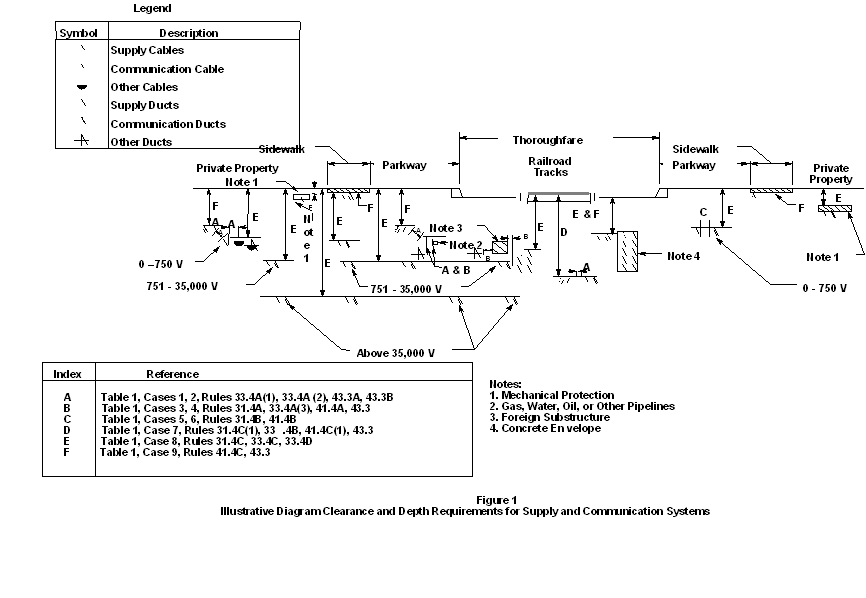
Typical Residential Supply and Communications System Direct Buried or Preassembled Cables-in-Ducts

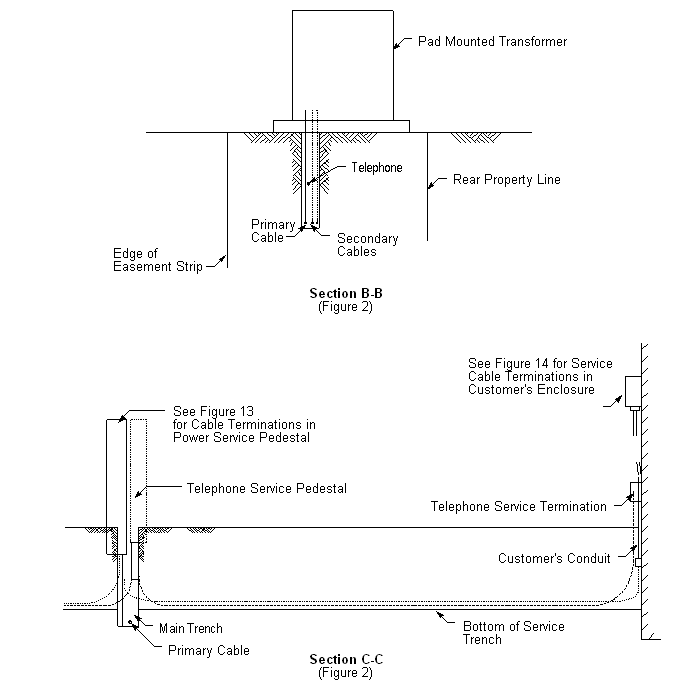


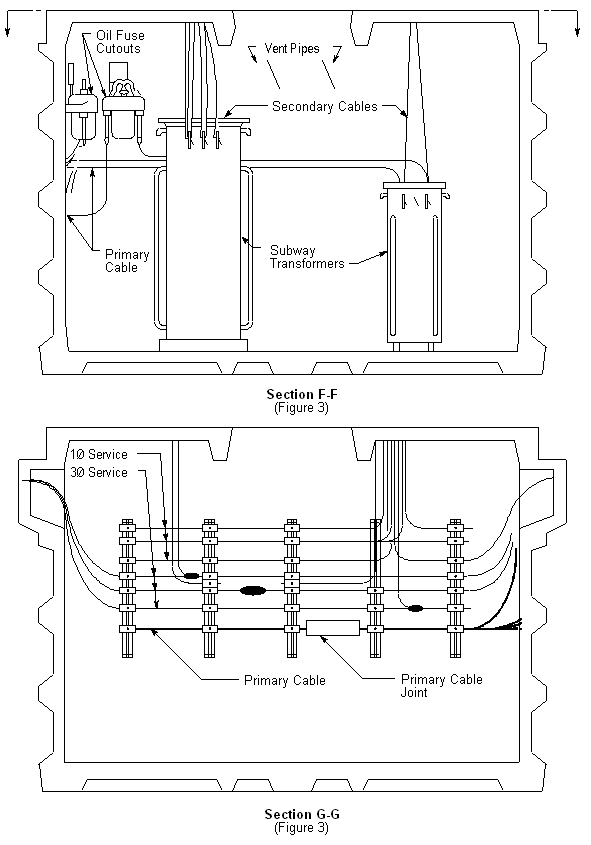

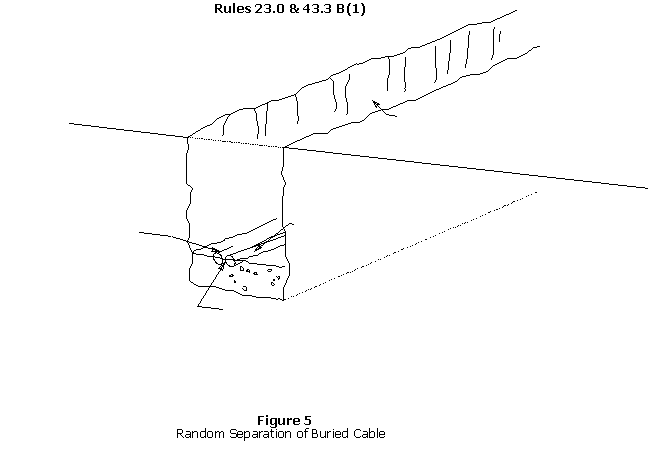
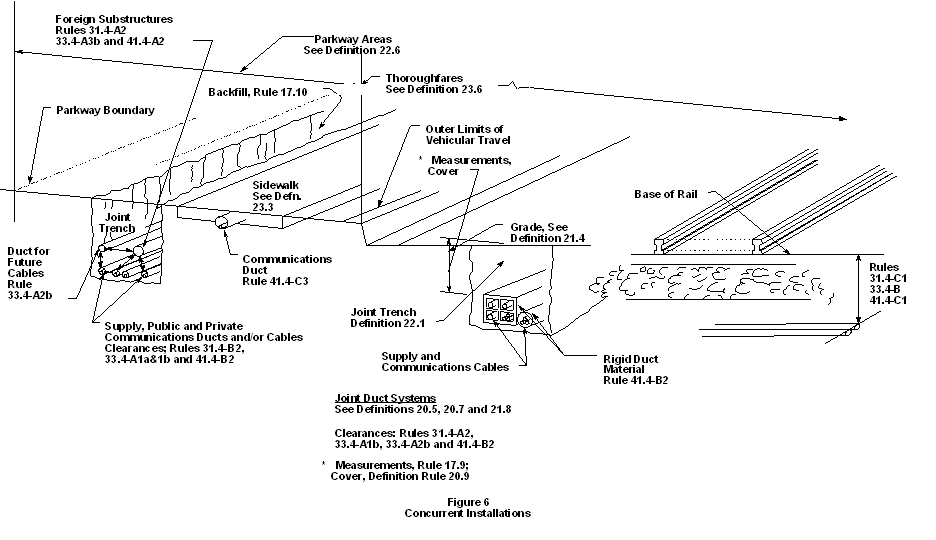
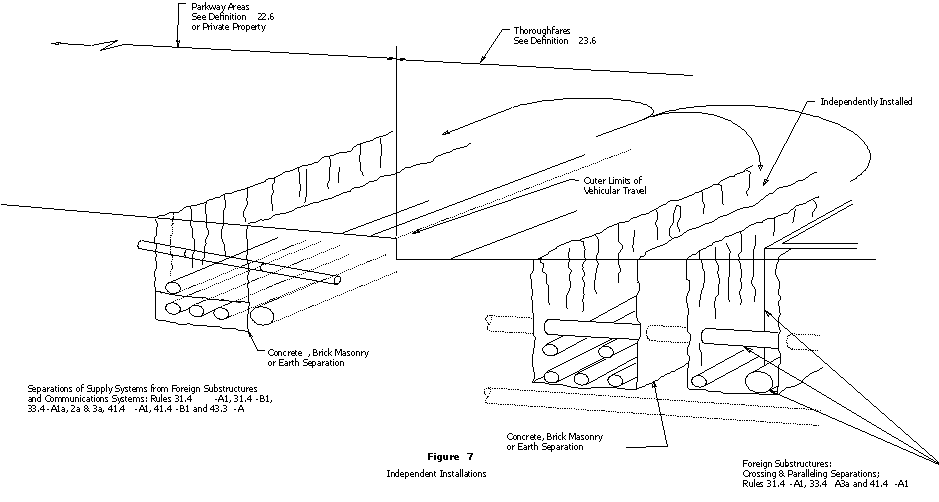
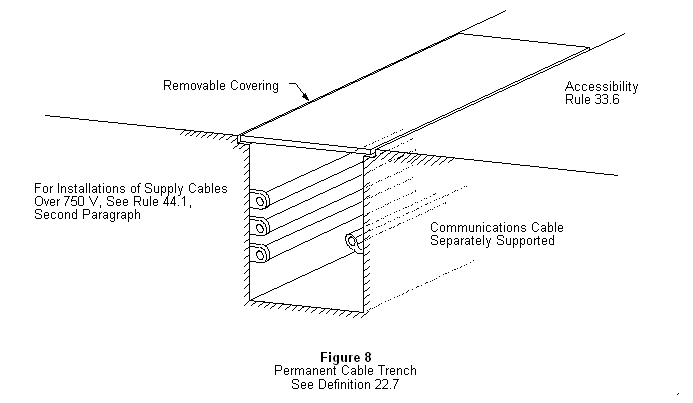
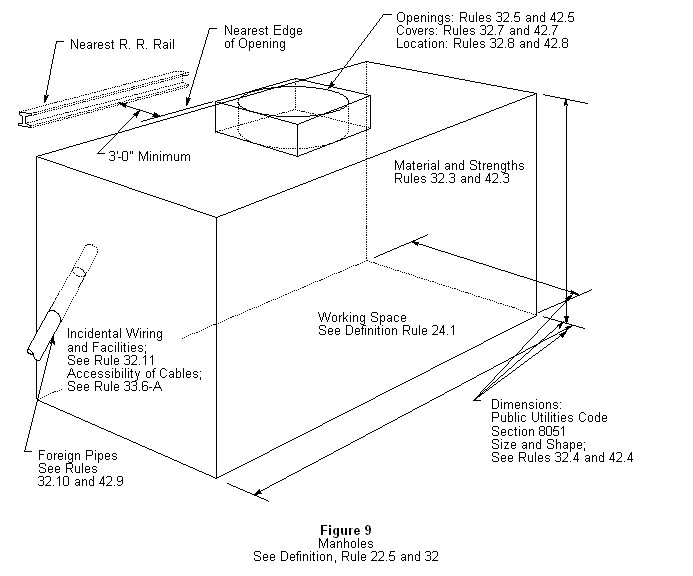
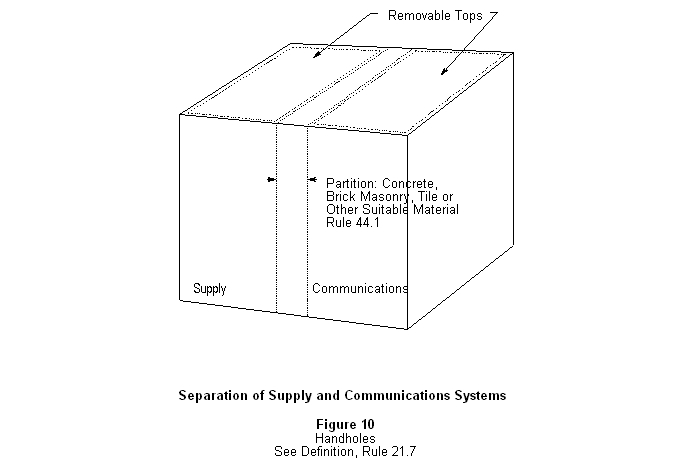
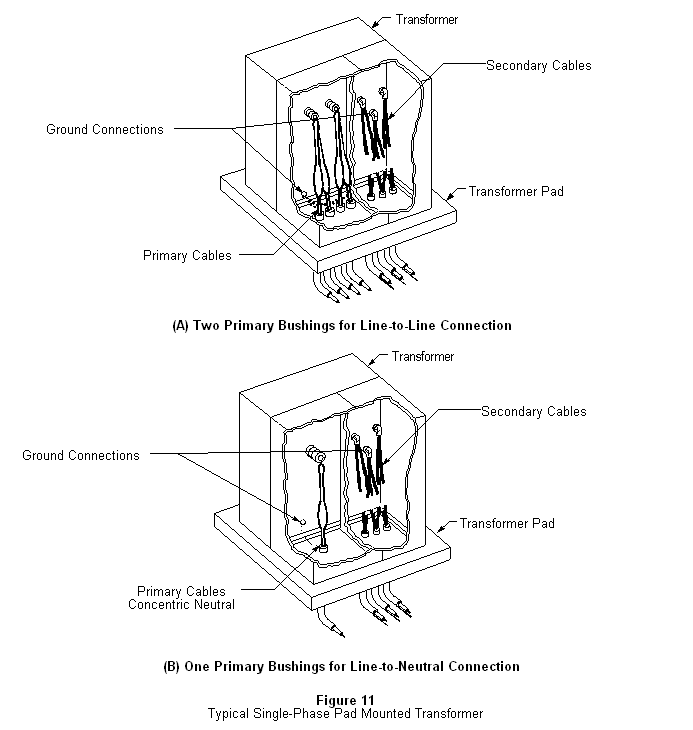
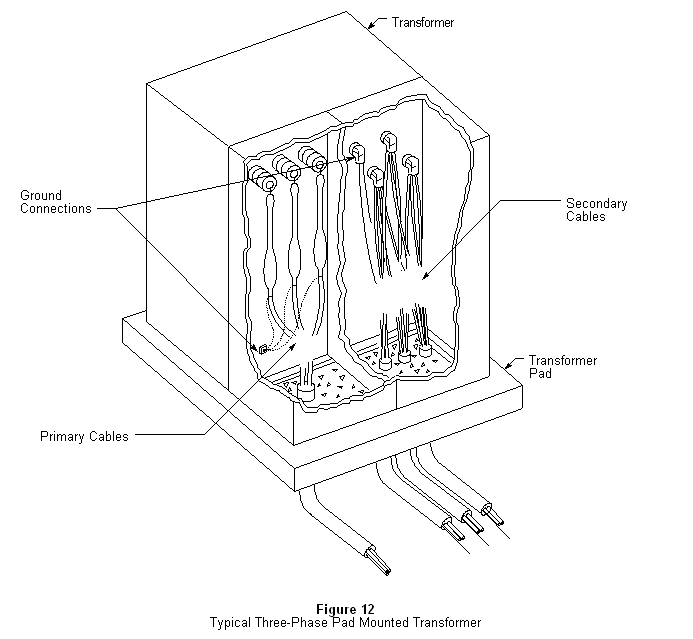

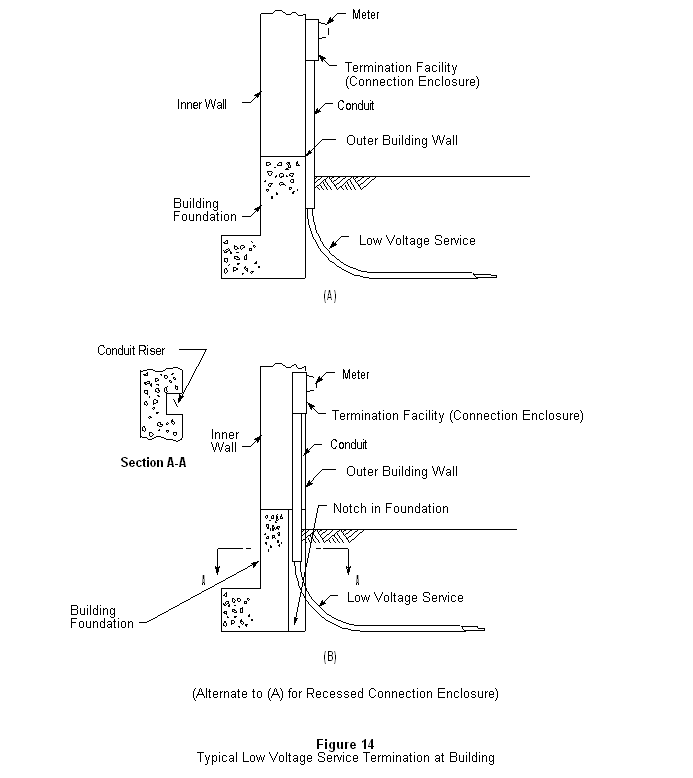

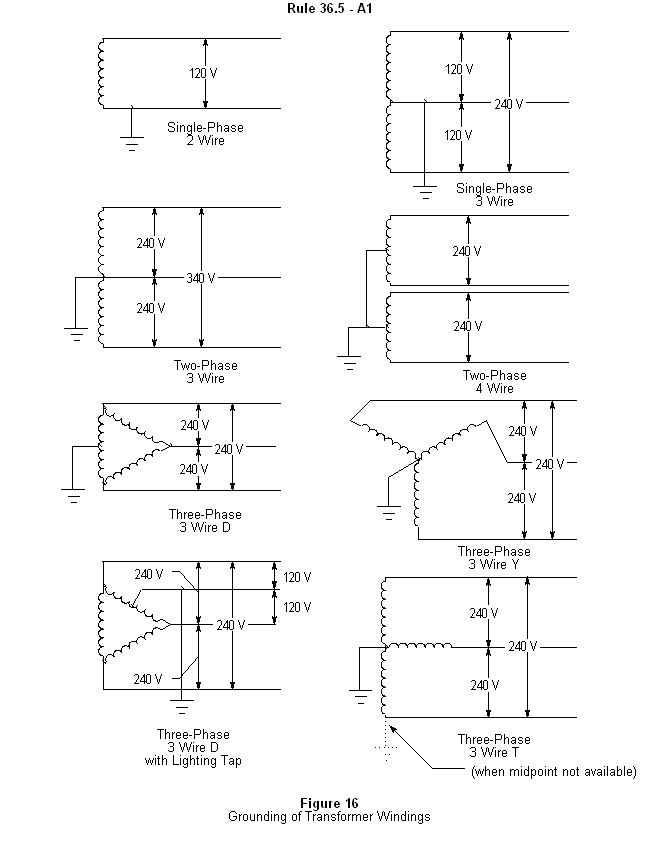
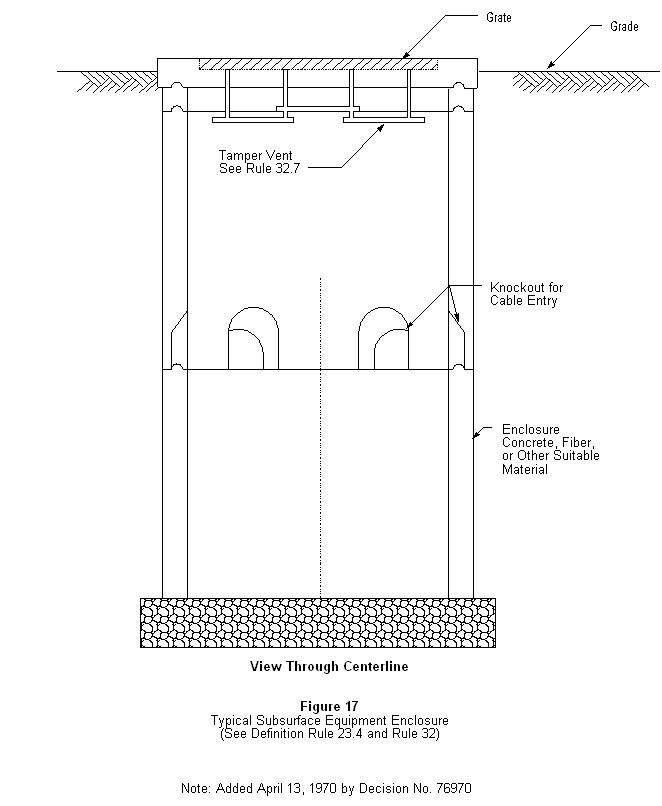
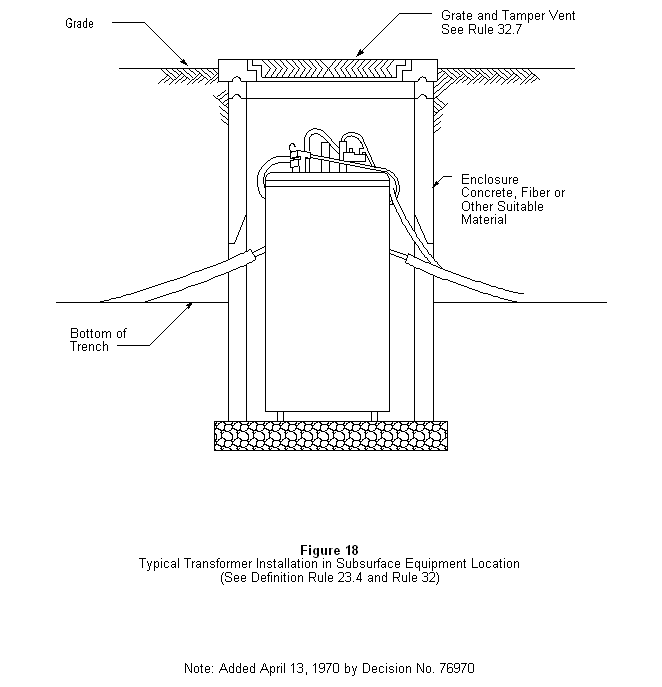
(This Page Intentionally Left Blank)
Appendix C
Clearance from Railroad Tracks
![]()
These diagrams illustrate the requirements of certain rules and are to be used as a guide only for the application of such rules. Under no condition shall these diagrams be given precedence over the rules as written.
Figure |
Title |
Page |
1 |
Typical Clearances For Above Ground Electrical Terminations Constructed Adjacent to Railroad Tracks |
C-3 |
2 |
Typical Installations of Manhole Covers Adjacent to Railroad Tracks |
C-4 |
(This Page Intentionally Left Blank)
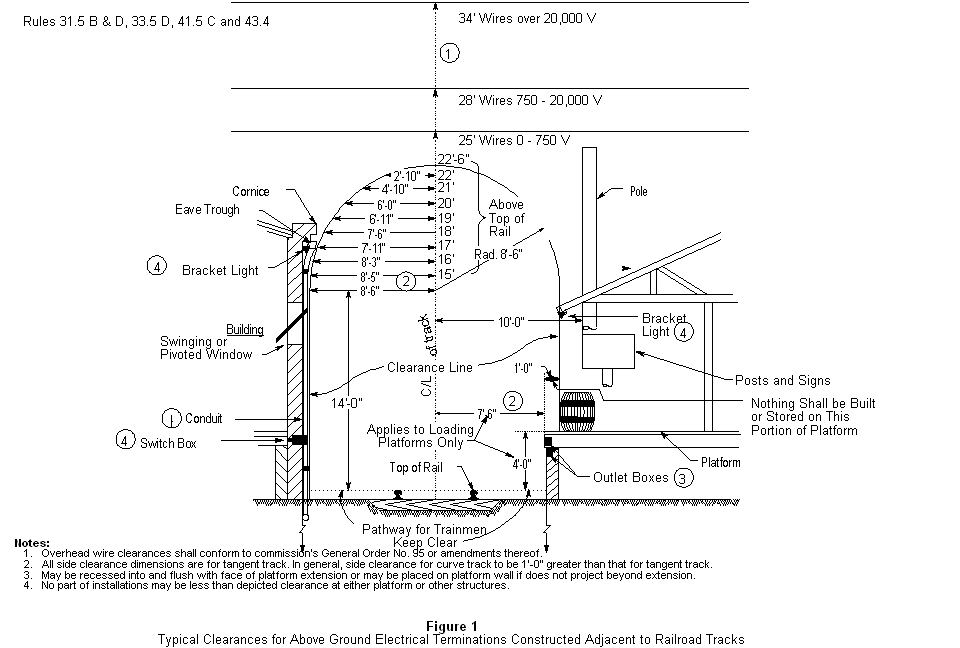
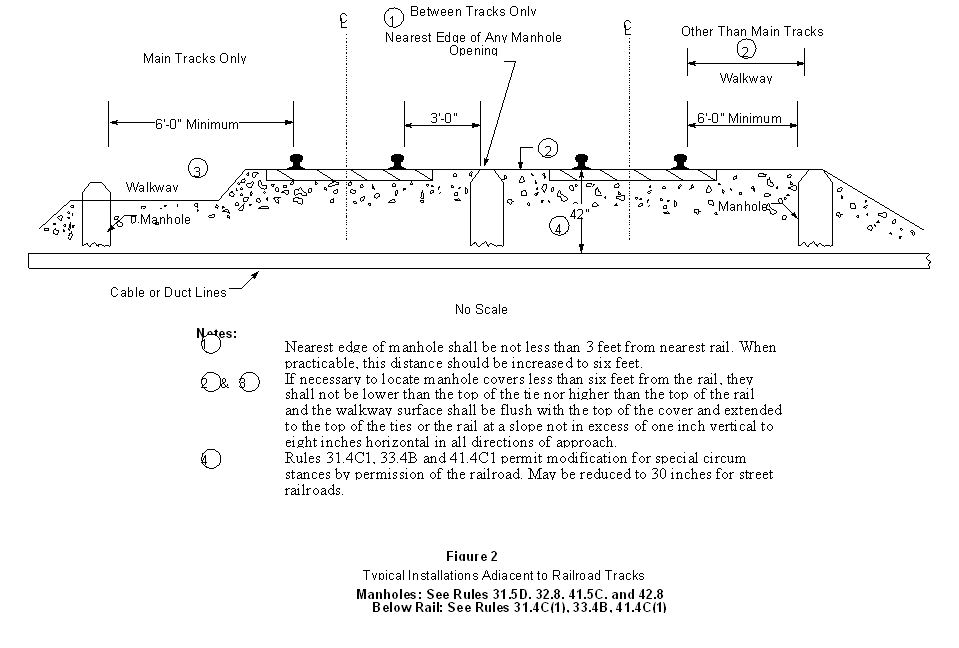
Appendix D
Excerpts from Public Utilities Code
![]()
Title |
Page |
Division 4, Chapter 5, Article 1, Sections 8001 - 8003 |
D-3 |
Division 4, Chapter 5, Article 3, Sections 8051 - 8057 |
D-3 and D-4 |
(This Page Intentionally Left Blank)
Appendix D
![]()
Statutes of 1951, Chapter No. 764, Public Utilities Code, Division 4, Chapter 5
![]()
Article 1
![]()
8001. Unless the particular provisions or the context otherwise requires, the definitions and general provisions contained in this article shall govern the construction of this chapter.
8002. "Person" includes any commission, officer, agent, or employee of this State, or of any county, city, city and county, or other political subdivision thereof, and any other person, firm, or corporation.
8003. "Signal wires or cables" include telephone, telegraph, and other signal wires.
Article 3
![]()
8051. No persons shall build or rebuild any subway, manhole, chamber, or underground room used or to be used to contain, encase, cover, or conduct any wire, cable, or appliance, to conduct or handle electricity, unless such subway, manhole, chamber, or underground room has an inside measurement of not less than four feet at the maximum points between the side walls thereof, and between the end walls thereof, and not less than five feet at all points between the floor and the top or ceiling thereof, or if circular in shape, at least four feet diameter inside measurement and not less than five feet at all points between the floor and ceiling thereof. This section does not apply to any such subway, manhole, chamber, or underground room, within which it is not intended or required that any human being perform work or labor or be employed. This section does not apply where satisfactory proof is submitted to the Commission that it is impracticable or physically impossible to comply with this law within the space or location so designated by the proper municipal authorities.
8052. No person shall build or rebuild in any subway, manhole, chamber or underground room used or to be used to contain, encase, cover, or conduct any wire, cable, or appliance to conduct or handle electricity, any opening to outer air which is less than 26 inches if circular in shape, or less than 24 inches by 26 inches clear measurement if rectangular in shape.
Appendix D, Article 3
![]()
8053. No person shall build or rebuild in any subway, manhole, chamber or underground room, used or to be used to contain, encase, cover, or conduct any wire, cable, or appliance to conduct or handle electricity, any opening which is at the surface of the ground, within the distance of three feet at any point from the rail of any railway or streetcar track. This section does not apply where satisfactory proof is submitted to the Commission that it is impracticable or physically impossible to comply with this law in the space or location so designated by the proper municipal authorities.
8054. No person shall build or rebuild any subway, manhole, chamber or underground room, used or to be used, to contain, encase, cover, or conduct any wire, cable, or appliance to conduct or handle electricity unless the floor of the subway, manhole, chamber, or underground room is made of stone, concrete, brick, or other similar material not subject to decomposition. This section does not apply to any subway, manhole, chamber, or underground room within which it is not intended or required that any human being perform work or labor or be employed.
8055. No person shall build or rebuild or maintain any subway, manhole, chamber, or underground room used, or to be used, to contain, encase, cover, or conduct any wire, cable, or appliance to conduct or handle electricity, unless such subway, manhole, chamber, or underground room is kept at all times in a sanitary condition and free from stagnant water, seepage, or other drainage, or any offensive matter dangerous to health, either by sewer connection or otherwise. This section does not apply to any subway, manhole, chamber, or underground room within which it is not intended or required that any human being perform work or labor, or be employed.
8056. The Commission may inspect all work which is included in the provisions of this article, and may make such further additions or changes as the Commission deems necessary for the purpose of safety to employees and the general public. The Commission shall enforce the provisions of this article.
8057. Any violation of any provision of this article is a misdemeanor.
